Percolation threshold
Percolation threshold is a mathematical concept related to percolation theory, which is the formation of long-range connectivity in random systems. Below the threshold a giant connected component does not exist; while above it, there exists a giant component of the order of system size. In engineering and coffee making, percolation represents the flow of fluids through porous media, but in the mathematics and physics worlds it generally refers to simplified lattice models of random systems or networks (graphs), and the nature of the connectivity in them. The percolation threshold is the critical value of the occupation probability p, or more generally a critical surface for a group of parameters p1, p2, ..., such that infinite connectivity (percolation) first occurs.
Percolation models
The most common percolation model is to take a regular lattice, like a square lattice, and make it into a random network by randomly "occupying" sites (vertices) or bonds (edges) with a statistically independent probability p. At a critical threshold pc, large clusters and long-range connectivity first appears, and this is called the percolation threshold. Depending on the method for obtaining the random network, one distinguishes between the site percolation threshold and the bond percolation threshold. More general systems have several probabilities p1, p2, etc., and the transition is characterized by a critical surface or manifold. One can also consider continuum systems, such as overlapping disks and spheres placed randomly, or the negative space (Swiss-cheese models).
In the systems described so far, it has been assumed that the occupation of a site or bond is completely random—this is the so-called Bernoulli percolation. For a continuum system, random occupancy corresponds to the points being placed by a Poisson process. Further variations involve correlated percolation, such as percolation clusters related to Ising and Potts models of ferromagnets, in which the bonds are put down by the Fortuin-Kasteleyn method.[1] In bootstrap or k-sat percolation, sites and/or bonds are first occupied and then successively culled from a system if a site does not have at least k neighbors. Another important model of percolation, in a different universality class altogether, is directed percolation, where connectivity along a bond depends upon the direction of the flow.
Over the last several decades, a tremendous amount of work has gone into finding exact and approximate values of the percolation thresholds for a variety of these systems. Exact thresholds are only known for certain two-dimensional lattices that can be broken up into a self-dual array, such that under a triangle-triangle transformation, the system remains the same. Studies using numerical methods have led to numerous improvements in algorithms and several theoretical discoveries.
The notation such as (4,82) comes from Grünbaum and Shephard,[2] and indicates that around a given vertex, going in the clockwise direction, one encounters first a square and then two octagons. Besides the eleven Archimedean lattices composed of regular polygons with every site equivalent, many other more complicated lattices with sites of different classes have been studied.
Error bars in the last digit or digits are shown by numbers in parentheses. Thus, 0.729724(3) signifies 0.729724 ± 0.000003, and 0.74042195(80) signifies 0.74042195 ± 0.00000080. The error bars variously represent one or two standard deviations in net error (including statistical and expected systematic error), or an empirical confidence interval.
Thresholds on Archimedean lattices

This is a picture of the 11 Archimedean Lattices or uniform tilings, in which all polygons are regular and each vertex is surrounded by the same sequence of polygons. The notation (34, 6) for example means that every vertex is surrounded by four triangles and one hexagon. Drawings from .[3] See also Uniform Tilings.
| Lattice | z | Site Percolation Threshold | Bond Percolation Threshold | |
|---|---|---|---|---|
| 3-12 or (3, 122 ) | 3 | 3 | 0.807900764... = (1 - 2 sin (π/18))1/2[4] | 0.7404207988509(8),[5][6] 0.740420800(2),[7] 0.74042195(80),[8] 0.74042077(2)[9] |
| cross (4, 6, 12) | 3 | 3 | 0.7478008(2),[5] 0.747806(4)[4] | 0.6937314(1),[5] 0.69373383(72)[8] |
| square octagon, bathroom tile, 4-8, truncated square
(4, 82) |
3 | 3 | 0.7297232(5),[5] 0.729724(3)[4] | 0.6768031269(6),[5] 0.67680232(63),[8] 0.6768 [10] |
| honeycomb (63) | 3 | 3 | 0.6962(6),[11] 0.697040230(5),[5] 0.6970402(1),[12] 0.6970413(10),[13] 0.697043(3),[4] | 0.652703645... = 1-2 sin (π/18), 1+ p3-3p2=0[14] |
| kagome (3, 6, 3, 6) | 4 | 4 | 0.652703645... = 1 - 2 sin(π/18)[14] | 0.524404978(5),[9] 0.52440499(2),[12] 0.52440572...,[15] 0.52440500(1),[7] 0.52440516(10),[13] 0.5244053(3),[16] |
| ruby,[18] rhombitrihexagonal (3, 4, 6, 4) | 4 | 4 | 0.62181207(7),[5] 0.621819(3)[4] | 0.5248311(1),[5] 0.52483258(53)[8] |
| square (44) | 4 | 4 | 0.59274605079210(2),[17] 0.59274601(2),[5] 0.59274605095(15),[19] 0.59274621(13),[20] 0.59274621(33),[21] 0.59274598(4),[22][23] 0.59274605(3),[12] 0.593(1),[24] | 1/2 |
| snub hexagonal, maple leaf [27] (34,6 ) | 5 | 5 | 0.579498(3)[4] | 0.43432764(3),[5] 0.43430621(50)[8] |
| snub square, puzzle (32, 4, 3, 4 ) | 5 | 5 | 0.550806(3)[4] | 0.4141378476 (7),[5] 0.41413743(46)[8] |
| frieze, (33, 42) | 5 | 5 | 0.550213(3),[4] 0.5502(8)[28] | 0.41964044(1),[5] 0.41964191(43),[8] 0.4196(6) [28] |
| triangular (36) | 6 | 6 | 1/2 | 0.347296355... = 2 sin (π/18), 1+ p3-3p=0[14] |
Note: sometimes "hexagonal" is used in place of honeycomb, although in some fields, a triangular lattice is also called a hexagonal lattice. z = bulk coordination number.
Square lattice with complex neighborhoods
| Lattice | z | Site Percolation Threshold | Bond Percolation Threshold |
|---|---|---|---|
| square: 3N, 4N, 6N | 4 | 0.592...[29][30] | |
| square: 3N+2N, 4N+3N, 6N+4N | 8 | 0.407...[29][30][31] | |
| square: 4N+2N | 8 | 0.337...[29][30] | |
| square: 6N+3N | 8 | 0.337...[30] | |
| square: 5N | 8 | 0.270...[30] | |
| square: 6N+2N | 8 | 0.277...[30] | |
| square: 4N+3N+2N | 12 | 0.288...[29][30] | |
| square: 6N+4N+3N | 12 | 0.288...[30] | |
| square: 5N+2N | 12 | 0.236...[30] | |
| square: 5N+3N | 12 | 0.225...[30] | |
| square: 5N+4N | 12 | 0.221...[30] | |
| square: 6N+3N+2N | 12 | 0.240...[30] | |
| square: 6N+4N+2N | 12 | 0.233...[30] | |
| square: 6N+5N | 12 | 0.199...[30] | |
| square: 5N+3N+2N | 16 | 0.219...[30] | |
| square: 5N+4N+2N | 16 | 0.208...[30] | |
| square: 5N+4N+3N | 16 | 0.202...[30] | |
| square: 6N+5N+2N | 16 | 0.187...[30] | |
| square: 6N+5N+3N | 16 | 0.182...[30] | |
| square: 6N+5N+4N | 16 | 0.179...[30] | |
| square: 6N+4N+3N+2N | 16 | 0.208...[30] | |
| square: 5N+4N+3N+2N | 20 | 0.196...[30] 0.196 724(5)[32] | |
| square: 6N+5N+3N+2N | 20 | 0.177...[30] | |
| square: 6N+5N+4N+2N | 20 | 0.172...[30] | |
| square: 6N+5N+4N+3N | 20 | 0.167...[30] | |
| square: 6N+5N+4N+3N+2N | 24 | 0.164...[30] | |
2N = nearest neighbors, 3N = next-nearest neighbors, 4N = next-next-nearest neighbors, etc. These are called NN, 2NN, 3NN respectively in the 3D versions below.
For more neighbors, see [32]
Approximate formulas for thresholds of Archimedean lattices
| Lattice | z | Site Percolation Threshold | Bond Percolation Threshold |
|---|---|---|---|
| (3, 122 ) | 3 | ||
| (4, 6, 12) | 3 | ||
| (4, 82) | 3 | 0.676835..., 4p3 + 3p4 - 6 p5- 2 p6 = 1 [33] | |
| honeycomb (63) | 3 | ||
| kagome (3, 6, 3, 6) | 4 | 0.524430..., 3p2 + 6p3 - 12 p4+ 6 p5 - p6 = 1 [34] | |
| (3, 4, 6, 4) | 4 | ||
| square (44) | 4 | 1/2 (exact) | |
| (34,6 ) | 5 | 0.434371..., 12p3 + 36p4 -21 p5- 327 p6 + 69p7 + 2532p8 - 6533 p9
+ 8256 p10 - 6255p11 + 2951p12 - 837 p13+ 126 p14 - 7p15= 1 [35] | |
| snub square, puzzle (32, 4, 3, 4 ) | 5 | ||
| (33, 42) | 5 | ||
| triangular (36) | 6 | 1/2 (exact) | |
Formulas for site-bond percolation
| Lattice | z | Threshold | Notes | |
|---|---|---|---|---|
| (63) honeycomb | 3 | 3 | ,
when equal: b = s = 0.82199 |
approximate formula, s = site prob., b = bond prob., t = 1 - 2 sin (π/18) [13] |
Archimedean Duals (Laves Lattices)
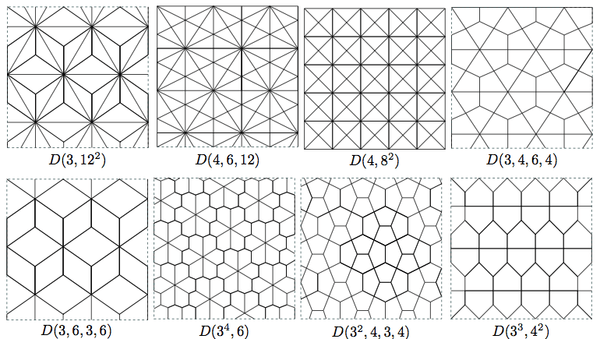
Laves lattices are the duals to the Archimedean lattices. Drawings from.[3] See also Uniform Tilings.
| Lattice | z | Site Percolation Threshold | Bond Percolation Threshold | |
|---|---|---|---|---|
| Cairo pentagonal
D(32,4,3,4)=(2/3)(53)+(1/3)(54) |
3,4 | 3⅓ | 0.6501834(2),[5] 0.650184(5)[3] | 0.585863... = 1-pcbond(32,4,3,4) |
| Pentagonal D(33,42)=(1/3)(54)+(2/3)(53) | 3,4 | 3⅓ | 0.6470471(2),[5] 0.647084(5),[3] 0.6471(6) [28] | 0.580358... = 1-pcbond(33,42), 0.5800(6) [28] |
| D(34,6)=(1/5)(46)+(4/5)(43) | 3,6 | 3 3/5 | 0.639447[3] | 0.565694... = 1-pcbond(34,6 ) |
| dice, rhombille tiling
D(3,6,3,6)=(1/3)(46)+(2/3)(43) |
3,6 | 4 | 0.5851(4),[36] 0.585040(5)[3] | 0.475595... = 1-pcbond(3,6,3,6 ) |
| ruby dual
D(3,4,6,4)=(1/6)(46)+(2/6)(43)+(3/6)(44) |
3,4,6 | 4 | 0.582410(5)[3] | 0.475167... = 1-pcbond(3,4,6,4 ) |
| union jack, tetrakis square tiling
D(4,82 )=(1/2)(34)+(1/2)(38) |
4,8 | 6 | 1/2 | 0.323197... = 1-pcbond(4,82 ) |
| bisected hexagon,[37] cross dual
D(4,6,12)= (1/6)(312)+(2/6)(36)+(1/2)(34) |
4,6,12 | 6 | 1/2 | 0.306266... = 1-pcbond(4,6,12) |
| asanoha (hemp leaf)[38]
D(3, 122)=(2/3)(33)+(1/3)(312) |
3,12 | 6 | 1/2 | 0.259579... = 1-pcbond(3, 122) |
Site bond percolation (both thresholds apply simultaneously to one system).
| Lattice | z | Site Percolation Threshold | Bond Percolation Threshold | |
|---|---|---|---|---|
| square | 4 | 4 | 0.615185(15)[39] | 0.95 |
| 0.667280(15)[39] | 0.85 | |||
| 0.732100(15)[39] | 0.75 | |||
| 0.75 | 0.726195(15)[39] | |||
| 0.815560(15)[39] | 0.65 | |||
| 0.85 | 0.615810(30)[39] | |||
| 0.95 | 0.533620(15)[39] |
* For more values, see An Investigation of site-bond percolation
2-Uniform Lattices
Top 3 Lattices: #13 #12 #36
Bottom 3 Lattices: #34 #37 #11

Top 2 Lattices: #35 #30
Bottom 2 Lattices: #41 #42
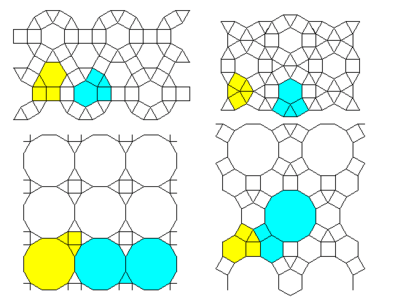
Top 4 Lattices: #22 #23 #21 #20
Bottom 3 Lattices: #16 #17 #15
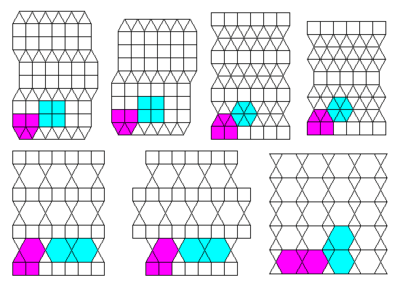
Top 2 Lattices: #31 #32
Bottom Lattice: #33
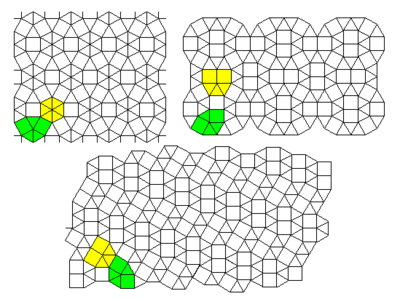
| # | Lattice | z | Site Percolation Threshold | Bond Percolation Threshold | |
|---|---|---|---|---|---|
| 41 | (1/2)(3,4,3,12) + (1/2)(3, 122) | 4,3 | 3.5 | 0.7680(2)[40] | 0.67493252(36)[41] |
| 42 | (1/3)(3,4,6,4) + (2/3)(4,6,12) | 4,3 | 3 1⁄3 | 0.7157(2)[40] | 0.64536587(40)[41] |
| 36 | (1/7)(36) + (6/7)(32,4,12) | 6,4 | 4 2⁄7 | 0.6808(2)[40] | 0.55778329(40)[41] |
| 15 | (2/3)(32,62) + (1/3)(3,6,3,6) | 4,4 | 4 | 0.6499(2)[40] | 0.53632487(40)[41] |
| 34 | (1/7)(36) + (6/7)(32,62) | 6,4 | 4 2⁄7 | 0.6329(2)[40] | 0.51707873(70)[41] |
| 16 | (4/5)(3,42,6) + (1/5)(3,6,3,6) | 4,4 | 4 | 0.6286(2)[40] | 0.51891529(35)[41] |
| 17 | (4/5)(3,42,6) + (1/5)(3,6,3,6)* | 4,4 | 4 | 0.6279(2)[40] | 0.51769462(35)[41] |
| 35 | (2/3)(3,42,6) + (1/3)(3,4,6,4) | 4,4 | 4 | 0.6221(2)[40] | 0.51973831(40)[41] |
| 11 | (1/2)(34,6) + (1/2)(32,62) | 5,4 | 4.5 | 0.6171(2)[40] | 0.48921280(37)[41] |
| 37 | (1/2)(33,42) + (1/2)(3,4,6,4) | 5,4 | 4.5 | 0.5885(2)[40] | 0.47229486(38)[41] |
| 30 | (1/2)(32,4,3,4) + (1/2)(3,4,6,4) | 5,4 | 4.5 | 0.5883(2)[40] | 0.46573078(72)[41] |
| 23 | (1/2)(33,42) + (1/2)(44) | 5,4 | 4.5 | 0.5720(2)[40] | 0.45844622(40)[41] |
| 22 | (2/3)(33,42) + (1/3)(44) | 5,4 | 4 2⁄3 | 0.5648(2)[40] | 0.44528611(40)[41] |
| 12 | (1/4)(36) + (3/4)(34,6) | 6,5 | 5 1⁄4 | 0.5607(2) [40] | 0.41109890(37) [41] |
| 33 | (1/2)(33,42) + (1/2)(32,4,3,4) | 5,5 | 5 | 0.5505(2) [40] | 0.41628021(35) [41] |
| 32 | (1/3)(33,42) + (2/3)(32,4,3,4) | 5,5 | 5 | 0.5504(2) [40] | 0.41549285(36) [41] |
| 31 | (1/7)(36) + (6/7)(32,4,3,4) | 6,5 | 5 1⁄7 | 0.5440(2) [40] | 0.40379585(40) [41] |
| 13 | (1/2)(36) + (1/2)(34,6) | 6,5 | 5.5 | 0.5407(2) [40] | 0.38914898(35) [41] |
| 21 | (1/3)(36) + (2/3)(33,42) | 6,5 | 5 1⁄3 | 0.5342(2) [40] | 0.39491996(40) [41] |
| 20 | (1/2)(36) + (1/2)(33,42) | 6,5 | 5.5 | 0.5258(2) [40] | 0.38285085(38) [41] |
Inhomogeneous 2-Uniform Lattice
This figure shows the 2-uniform lattice #37 in the isoradial representation in which each polygon is inscribed in a circle of unit radius. The squares in the 2-uniform lattice must now be represented as rectangles in order to satisfy the isoradial condition. The lattice is shown by black edges, and the dual lattice by red dashed lines. The green circles show the isoradial constraint on both the original and dual lattices. The yellow polygons highlight the three types of polygons on the lattice, and the pink polygons highlight the two types of polygons on the dual lattice. The lattice has vertex types (1/2)(33,42) + (1/2)(3,4,6,4), while the dual lattice has vertex types (1/15)(46)+(6/15)(42,52)+(2/15)(53)+(6/15)(52,4). The critical point is where the longer bonds (on both the lattice and dual lattice) have occupation probability p = 2 sin (π/18) = 0.347296... which is the bond percolation threshold on a triangular lattice, and the shorter bonds have occupation probability 1 - 2 sin(π/18) = 0.652703..., which is the bond percolation on a hexagonal lattice. These results follow from the isoradial condition [42] but also follow from applying the star-triangle transformation to certain stars on the honeycomb lattice. Finally, it can be generalized to having three different probabilities in the three different directions, p1, p2 and p3 for the long bonds, and 1 - p1, 1 - p2, and 1 - p3 for the short bonds, where p1, p2 and p3 satisfy the critical surface for the inhomogeneous triangular lattice.
Thresholds on 2D bow-tie and martini lattices
To the left, center, and right are: the martini lattice, the martini-A lattice, the martini-B lattice. Below: the martini covering/medial lattice, same as the 2x2, 1x1 subnet for kagome-type lattices (removed).

Some other examples of generalized bow-tie lattices (a-d) and the duals of the lattices (e-h)
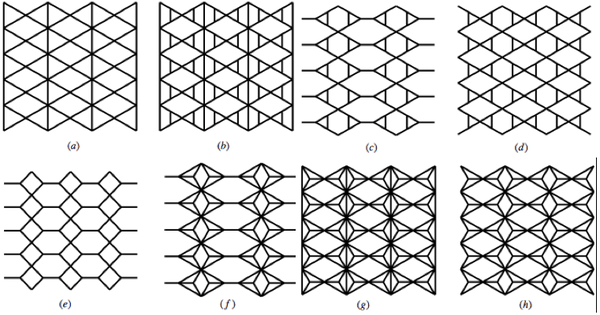
| Lattice | z | Site Percolation Threshold | Bond Percolation Threshold | |
|---|---|---|---|---|
| martini (3/4)(3,92)+(1/4)(93) | 3 | 3 | 0.764826..., 1 +p4 - 3p3=0[43] | 0.707107... = 1/√2 [44] |
| bow-tie (c) | 3,4 | 3 1/7 | 0.672929..., 1-2p3-2p4-2p5-7p6+18p7+11p8-35p9+21p10-4p11=0 [45] | |
| bow-tie (d) | 3,4 | 3⅓ | 0.625457..., 1-2p2-3p3+4p4-p5=0 [45] | |
| martini-A (2/3)(3,72)+(1/3)(3,73) | 3,4 | 3⅓ | 1/√2[45] | 0.625457..., 1-2p2-3p3+4p4-p5=0 [45] |
| bow-tie dual lattice (e) | 3,4 | 3⅔ | 0.595482..., 1-pcbond (bow-tie (a)) [45] | |
| bow-tie (b) | 3,4,6 | 3⅔ | 0.533213..., 1-p- 2p3 -4p4-4p5+156+ 13p7-36p8+19p9+ p10 + p11=0 [45] | |
| martini covering/medial (1/2)(33,9)+(1/2)(3,9,3,9) | 4 | 4 | 0.707107... = 1/√2 [44] | 0.57086651(33) [46] |
| martini-B (1/2)(3,5,3,52)+(1/2)(3,52) | 3, 5 | 4 | 0.618034... = 2/(1 +√5)..., 1- p2-p=0[43][45] | 1/2 [44][45] |
| bow-tie dual lattice (f) | 3,4,8 | 4 2/5 | 0.466787..., 1-pcbond (bow-tie (b))[45] | |
| bow-tie (a) (1/2)(32,4,32,4)+(1/2)(3,4,3) | 4,6 | 5 | 0.5472(2) [28] | 0.404518..., 1 - p - 6p2 +6p3-p5=0 [45] |
| bow-tie dual lattice (h) | 3,6,8 | 5 | 0.374543..., 1-pcbond(bow-tie (d))[45] | |
| bow-tie dual lattice (g) | 3,6,10 | 5½ | 0.547... = pcsite(bow-tie(a)) | 0.327071..., 1-pcbond(bow-tie (c))[45] |
Thresholds on 2D covering, medial, and matching lattices
| Lattice | z | Site Percolation Threshold | Bond Percolation Threshold | |
|---|---|---|---|---|
| (4, 6, 12) covering/medial | 4 | 4 | pcbond(4, 6, 12) = 0.693731... | 0.5593140(2),[5] 0.559315(1)[47] |
| (4, 82) covering/medial, square kagome | 4 | 4 | pcbond(4,82) = 0.676803... | 0.544798017(4),[5] 0.54479793(34)[47] |
| (34, 6) medial | 4 | 4 | 0.5247495(5)[5] | |
| (3,4,6,4) medial | 4 | 4 | 0.51276 [5] | |
| (32, 4, 3, 4) medial | 4 | 4 | 0.512682929(8)[5] | |
| (33, 42) medial | 4 | 4 | 0.5125245984(9)[5] | |
| square covering (non-planar) | 6 | 6 | 1/2 | 0.3371(1)[48] |
| square matching lattice (non-planar) | 8 | 8 | 1 - pcsite(square) = 0.407253... | 0.25036834(6)[12] |
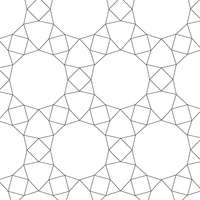
(4, 6, 12) covering/medial lattice
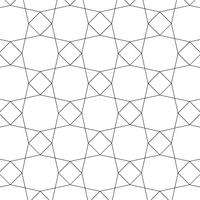
(4, 82) covering/medial lattice
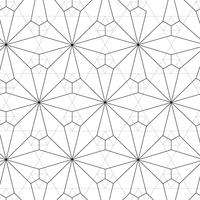
(3,122) covering/medial lattice (in light grey), equivalent to the kagome (2 x 2) subnet, and in black, the dual of these lattices.
_medial_lattice.png)
_medial_dual.png)
(left) (3,4,6,4) covering/medial lattice, (right) (3,4,6,4) medial dual, shown in red, with medial lattice in light gray behind it
Thresholds on 2D chimera non-planar lattices
| Lattice | z | Site Percolation Threshold | Bond Percolation Threshold | |
|---|---|---|---|---|
| K(2,2) | 4 | 4 | 0.51253(14)[49] | 0.44778(15) [49] |
| K(3,3) | 6 | 6 | 0.43760(15) [49] | 0.35502(15) [49] |
| K(4,4) | 8 | 8 | 0.38675(7) [49] | 0.29427(12) [49] |
| K(5,5) | 10 | 10 | 0.35115(13) [49] | 0.25159(13) [49] |
| K(6,6) | 12 | 12 | 0.32232(13)[49] | 0.21942(11) [49] |
| K(7,7) | 14 | 14 | 0.30052(14) [49] | 0.19475(9) [49] |
| K(8,8) | 16 | 16 | 0.28103(11) [49] | 0.17496(10) [49] |
Thresholds on subnet lattices
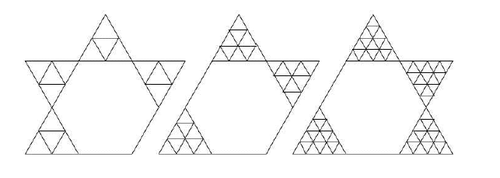
The 2 x 2, 3 x 3, and 4 x 4 subnet kagome lattices. The 2 × 2 subnet is also known as the "triangular kagome" lattice [50]
| Lattice | z | Site Percolation Threshold | Bond Percolation Threshold | |
|---|---|---|---|---|
| checkerboard – 2 × 2 subnet | 4,3 | 0.596303(1) [51] | ||
| checkerboard – 4 × 4 subnet | 4,3 | 0.633685(9) [51] | ||
| checkerboard – 8 × 8 subnet | 4,3 | 0.642318(5) [51] | ||
| checkerboard – 16 × 16 subnet | 4,3 | 0.64237(1) [51] | ||
| checkerboard- 32 × 32 subnet | 4,3 | 0.64219(2) [51] | ||
| checkerboard – subnet | 4,3 | 0.642216(10) [51] | ||
| kagome – 2 × 2 subnet = (3, 122) covering/medial | 4 | pcbond (3, 122) = 0.74042077... | 0.600861966960(2),[5] 0.6008624(10),[13] 0.60086193(3)[9] | |
| kagome – 3 × 3 subnet | 4 | 0.6193296(10),[13] 0.61933176(5),[9] 0.61933044(32)[52] | ||
| kagome – 4 × 4 subnet | 4 | 0.625365(3),[13] 0.62536424(7)[9] | ||
| kagome – subnet | 4 | 0.628961(2) [13] | ||
| kagome – (1 × 1):(2 × 2) subnet = martini covering/medial | 4 | pcbond(martini) = 1/√2 = 0.707107... | 0.57086648(36) [46] | |
| kagome – (1 × 1):(3 × 3) subnet | 4,3 | 0.728355596425196...[9] | 0.58609776(37) [52] | |
| kagome – (1 × 1):(4 × 4) subnet | 0.738348473943256...[9] | |||
| kagome – (1 × 1):(5 × 5) subnet | 0.743548682503071...[9] | |||
| kagome – (1 × 1):(6 × 6) subnet | 0.746418147634282...[9] | |||
| kagome – (2 × 2):(3 × 3) subnet | 0.61091770(30) [52] | |||
| triangular – 2 × 2 subnet | 6,4 | 0.471628788 [51] | ||
| triangular – 3 × 3 subnet | 6,4 | 0.509077793 [51] | ||
| triangular – 4 × 4 subnet | 6,4 | 0.524364822 [51] | ||
| triangular – 5 × 5 subnet | 6,4 | 0.5315976(10) [51] | ||
| triangular – subnet | 6,4 | 0.53993(1) [51] |
Thresholds of random sequentially adsorbed objects
| system | z | Site Threshold |
|---|---|---|
| dimers on a square lattice | 4 | 0.5617,[53] 0.562 [54] |
| dimers on a triangular lattice | 6 | 0.4872(8)[55] |
| dimers and 5% impurities, triangular lattice | 6 | 0.4832(7) [56] |
| linear 3-mers on a square lattice | 4 | 0.528[54] |
| 3-site 120° angle, 5% impurities, triangular lattice | 6 | 0.4574(9)[56] |
| 3-site triangles, 5% impurities, triangular lattice | 6 | 0.5222(9)[56] |
| linear trimers and 5% impurities, triangular lattice | 6 | 0.4603(8) [56] |
| linear 4-mers on a square lattice | 4 | 0.504[54] |
| linear 5-mers on a square lattice | 4 | 0.490[54] |
| linear 6-mers on a square lattice | 4 | 0.479[54] |
| linear 8-mers on a square lattice | 4 | 0.474[54] |
| linear 10-mers on a square lattice | 4 | 0.469[54] |
| parallel dimers on a square lattice | 4 | 0.5683[53] |
The threshold gives the fraction of sites occupied by the objects when site percolation first takes place (not at full jamming). For longer dimers see Ref.[57]
Thresholds of full dimer coverings of two dimensional lattices
Here, we are dealing with networks that are obtained by covering a lattice with dimers, and then consider bond percolation on the remaining bonds. In discrete mathematics, this problem is known as the 'perfect matching' or the 'dimer covering' problem.
| system | z | Bond Threshold |
|---|---|---|
| Parallel covering, square lattice | 6 | 0.381966...[58] |
| Shifted covering, square lattice | 6 | 0.347296...[58] |
| Staggered covering, square lattice | 6 | 0.376825(2) [58] |
| Random covering, square lattice | 6 | 0.367713(2) [58] |
| Parallel covering, triangular lattice | 10 | 0.237418...[58] |
| Staggered covering, triangular lattice | 10 | 0.237497(2) [58] |
| Random covering, triangular lattice | 10 | 0.235340(1) [58] |
Thresholds of polymers (random walks) on a square lattice
System is composed of ordinary (non-avoiding) random walks of length l on the square lattice. [59]
| l (polymer length) | z | Bond Percolation |
|---|---|---|
| 1 | 4 | 0.5(exact) [60] |
| 2 | 4 | 0.47697(4)[60] |
| 4 | 4 | 0.44892(6) [60] |
| 8 | 4 | 0.41880(4)[60] |
Thresholds of self-avoiding walks of length k added by random sequential adsorption
| k | z | Site Thresholds | Bond Thresholds |
|---|---|---|---|
| 1 | 4 | 0.593(2) [61] | 0.5009(2) [61] |
| 2 | 4 | 0.564(2) [61] | 0.4859(2) [61] |
| 3 | 4 | 0.552(2) [61] | 0.4732(2) [61] |
| 4 | 4 | 0.542(2) [61] | 0.4630(2) [61] |
| 5 | 4 | 0.531(2) [61] | 0.4565(2) [61] |
| 6 | 4 | 0.522(2) [61] | 0.4497(2) [61] |
| 7 | 4 | 0.511(2) [61] | 0.4423(2) [61] |
| 8 | 4 | 0.502(2) [61] | 0.4348(2) [61] |
| 9 | 4 | 0.493(2) [61] | 0.4291(2) [61] |
| 10 | 4 | 0.488(2) [61] | 0.4232(2) [61] |
| 11 | 4 | 0.482(2) [61] | 0.4159(2) [61] |
| 12 | 4 | 0.476(2) [61] | 0.4114(2) [61] |
| 13 | 4 | 0.471(2) [61] | 0.4061(2) [61] |
| 14 | 4 | 0.467(2) [61] | 0.4011(2) [61] |
| 15 | 4 | 0.4011(2) [61] | 0.3979(2) [61] |
Thresholds on 2D inhomogeneous lattices
| Lattice | z | Site Percolation Threshold | Bond Percolation Threshold |
|---|---|---|---|
| bow-tie with p = 1/2 on one non-diagonal bond | 3 | 0.3819654(5),[62] [33] | |
Thresholds for 2D continuum models
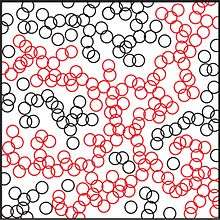
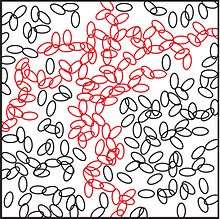
| System | Φc | ηc | nc |
|---|---|---|---|
| Disks of radius r | 0.6763475(6),[63] 0.676339(4) [64] | 1.12808737(6),[65] 1.128085(2),[63] 1.128059(12) [64] | 1.436322(2),[63] 1.436289(16) [64] |
| Ellipses, aspect ratio ε = 2 | 0.63 [66] | 0.76 | 1.94 |
| Ellipses, ε = 5 | 0.455 [67] | 0.607 | 3.864 |
| Ellipses, ε = 10 | 0.301 [67] | 0.358 | 4.56 |
| Ellipses, ε = 20 | 0.178 [67] | 0.196 | 4.99 |
| Ellipses, ε = 50 | 0.081 [67] | 0.084 | 5.38 |
| Ellipses, ε = 100 | 0.0417 [67] | 0.0426 | 5.42 |
| Ellipses, ε = 1000 | 0.0043 [67] | 0.00431 | 5.5 |
| Aligned squares of side | 0.66674349(3),[65] 0.66653(1),[68] 0.6666(4)[69] | 1.09884280(9),[65] 1.0982(3),[68] 1.098(1)[69] | 1.09884280(9),[65] 1.0982(3),[68] 1.098(1)[69] |
| Randomly oriented squares | 0.62554075(4),[65] 0.6254(2)[69] | 0.9822723(1),[65] 0.9819(6)[69] 0.982278(14) [70] | 0.9822723(1),[65] 0.9819(6)[69] 0.982278(14) [70] |
| Rectangles, ε = 1.1 | 0.624870(7) | 0.980484(19) | 1.078532(21) [70] |
| Rectangles, ε = 2 | 0.590635(5) | 0.893147(13) | 1.786294(26) [70] |
| Rectangles, ε = 3 | 0.5405983(34) | 0.777830(7) | 2.333491(22) [70] |
| Rectangles, ε = 4 | 0.4948145(38) | 0.682830(8) | 2.731318(30) [70] |
| Rectangles, ε = 5 | 0.4551398(31) | 0.607226(6) | 3.036130(28) [70] |
| Rectangles, ε = 10 | 0.3233507(25) | 0.3906022(37) | 3.906022(37) [70] |
| Rectangles, ε = 20 | 0.2048518(22) | 0.2292268(27) | 4.584535(54) [70] |
| Rectangles, ε = 50 | 0.09785513(36) | 0.1029802(4) | 5.149008(20) [70] |
| Rectangles, ε = 100 | 0.0523676(6) | 0.0537886(6) | 5.378856(60) [70] |
| Rectangles, ε = 200 | 0.02714526(34) | 0.02752050(35) | 5.504099(69) [70] |
| Rectangles, ε = 1000 | 0.00559424(6) | 0.00560995(6) | 5.609947(60) [70] |
| Sticks of length | 5.6372858(6),[65] 5.63726(2) [71] | ||
| Power-law disks, x=2.05 | 0.993(1) [72] | 4.90(1) | 0.0380(6) |
| Power-law disks, x=2.25 | 0.8591(5) [72] | 1.959(5) | 0.06930(12) |
| Power-law disks, x=2.5 | 0.7836(4) [72] | 1.5307(17) | 0.09745(11) |
| Power-law disks, x=4 | 0.69543(6) [72] | 1.18853(19) | 0.18916(3) |
| Power-law disks, x=5 | 0.68643(13) [72] | 1.1597(3) | 0.22149(8) |
| Power-law disks, x=6 | 0.68241(8) [72] | 1.1470(1) | 0.24340(5) |
| Power-law disks, x=7 | 0.6803(8) [72] | 1.140(6) | 0.25933(16) |
| Power-law disks, x=8 | 0.67917(9) [72] | 1.1368(5) | 0.27140(7) |
| Power-law disks, x=9 | 0.67856(12) [72] | 1.1349(4) | 0.28098(9) |
| Voids around disks of radius r | 1 - Φc(disk) = 0.32355169(2),[65] 0.318(2),[73] 0.3261(6)[74] | ||
equals critical total area for disks, where N is the number of objects and L is the system size.
for ellipses of semi-major and semi-minor axes of a and b, respectively. Aspect ratio with .
for rectangles of dimensions and . Aspect ratio with .
for power-law distributed disks with , .
equals critical area fraction.
equals number of objects of maximum length per unit area.
For ellipses,
For void percolation, is the critical void fraction.
For more ellipse values, see [66]
For more rectangle values, see [70]
Thresholds on 2D random and quasi-lattices

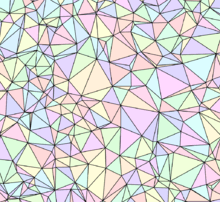
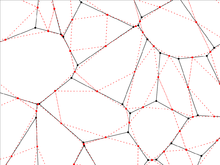
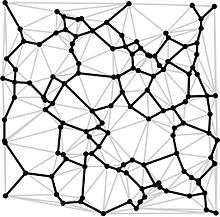
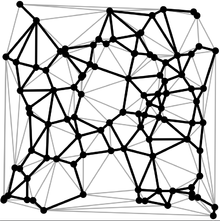
| Lattice | z | Site Percolation Threshold | Bond Percolation Threshold | |
|---|---|---|---|---|
| Relative neighborhood graph | 2.5576 | 0.796(2) [75] | 0.771(2) [75] | |
| Voronoi tessellation | 3 | 0.71410(2),[76] 0.7151* [40] | 0.68,[77] 0.666931(5),[76] 0.6670(1) [78] | |
| Voronoi covering/medial | 4 | 0.666931(2)[76][78] | 0.53618(2) [76] | |
| Randomized kagome/square-octagon, fraction r=1/2 | 4 | 0.6599[10] | ||
| Penrose rhomb dual | 4 | 0.6381(3)[36] | 0.5233(2) [36] | |
| Gabriel graph | 4 | 0.6348(8),[79] 0.62[80] | 0.5167(6),[79] 0.52[80] | |
| Random-line tessellation, dual | 4 | 0.586(2)[81] | ||
| Penrose rhomb | 4 | 0.5837(3),[36] 0.58391(1)[82] | 0.4770(2) [36] | |
| Octagonal lattice, "chemical" links (Ammann Beenker tiling) | 4 | 0.585 [83] | 0.48 [83] | |
| Octagonal lattice, "ferromagnetic" links | 5.17 | 0.543 [83] | 0.40 [83] | |
| Dodecagonal lattice, "chemical" links | 3.63 | 0.628 [83] | 0.54 [83] | |
| Dodecagonal lattice, "ferromagnetic" links | 4.27 | 0.617 [83] | 0.495 [83] | |
| Delaunay triangulation | 6 | 1/2 [84] | 0.333069(2) [76][78] | |
*Theoretical estimate
Thresholds on slabs
| Lattice | z | Site Percolation Threshold 0.67634831(2),[65] | Bond Percolation Threshold | |
|---|---|---|---|---|
| h= 2, SC, open b.c. | 0.47424 [85] | |||
| h = 3, BCC, periodic b.c. | 0.21113018(38) [86] | |||
| h = 4, BCC, periodic b.c. | 0.20235168(59) [86] | |||
| h= 4, SC, open b.c. | 0.3997 [85] | |||
| h = 5, SC, periodic b.c. | 0.278102(5) [86] | |||
| h = 6, SC, periodic b.c. | 0.272380(2) [86] | |||
| h = 7, SC, periodic b.c. | 5,6 | 5,6 | 0.3459514(12) [86] | 0.268459(1) [86] |
| h= 8, SC, open b.c. | 0.3557 [85] | |||
| h = 8, SC, periodic b.c. | 0.265615(5) [86] | |||
More for SC open b.c. in Ref.[85]
h is the thickness of the slab, h x ∞ x ∞.
Thresholds on 3D lattices
| Lattice | z | filling factor* | filling fraction* | Site Percolation Threshold | Bond Percolation Threshold | |
|---|---|---|---|---|---|---|
| (10,3)-a oxide (or site-bond) [87] | 2.4 | 0.748713(22)[87] | ||||
| (10,3)-b oxide (or site-bond) [87] | 2.4 | 0.745317(25)[87] | ||||
| silicon dioxide (diamond site-bond) [87] | 2 ⅔ | 0.638683(35)[87] | ||||
| (8,3)-a[88] | 3 | 3 | 0.577962(33)[88] | 0.555700(22)[88] | ||
| (10,3)-a[88] | 3 | 3 | 0.571404(40)[88] | 0.551060(37)[88] | ||
| (10,3)-b[88] | 3 | 3 | 0.565442(40)[88] | 0.546694(33)[88] | ||
| cubic oxide (cubic site-bond)[87] | 3 | 0.524652(50)[87] | ||||
| bcc dual | 4 | 0.4560(6) [89] | 0.4031(6) [89] | |||
| ice Ih | 4 | 4 | π √3 / 16 = 0.340087 | 0.147 | 0.433(11)[90] | 0.388(10)[91] |
| diamond (Ice Ic) | 4 | 4 | π √3 / 16 = 0.340087 | 0.1462332 | 0.4299870(4),[92] 0.426(+0.08,-0.02),[93] | 0.3895892(5),[92] 0.3893(2),[94] |
| diamond dual | 6 2/3 | 0.3904(5) [89] | 0.2350(5)[89] | |||
| 3D kagome (covering graph of the diamond lattice) | 6 | π √2 / 12 = 0.37024 | 0.1442 | 0.3895(2)[97] =pc(site) for diamond dual and pc(bond) for diamond lattice [89] | 0.2709(6)[89] | |
| Bow-tie stack dual | 5⅓ | 0.3480(4)[28] | 0.2853(4)[28] | |||
| honeycomb stack | 5 | 5 | 0.3701(2) [28] | 0.3093(2) [28] | ||
| octagonal stack dual | 5 | 5 | 0.3840(4) [28] | 0.3168(4) [28] | ||
| pentagonal stack | 5⅓ | 0.3394(4) [28] | 0.2793(4) [28] | |||
| kagome stack | 6 | 6 | 0.453450 | 0.1517 | 0.3346(4) [28] | 0.2563(2) [28] |
| fcc dual | 42,8 | 5 1/3 | 0.3341(5) [89] | 0.2703(3) [89] | ||
| simple cubic | 6 | 6 | π / 6 = 0.5235988 | 0.1631574 | 0.307(10) [96] 0.3115(5),[98] 0.3116077(2),[99] 0.311604(6),[100]
0.311605(5),[101] 0.311600(5),[102] 0.3116077(4),[103] 0.3116081(13),[104] 0.3116080(4),[105] 0.3116004(35),[106] 0.31160768(15)[92] |
0.247(5) [96] |
| hcp dual | 44,82 | 5 1/3 | 0.3101(5) [89] | 0.2573(3) [89] | ||
| dice stack | 5,8 | 6 | π √3 / 9 = 0.604600 | 0.1813 | 0.2998(4) [28] | 0.2378(4) [28] |
| bow-tie stack | 7 | 7 | 0.2822(6) [28] | 0.2092(4) [28] | ||
| Stacked triangular / simple hexagonal | 8 | 8 | 0.26240(5),[109] 0.2625(2),[110] 0.2623(2)[28] | 0.18602(2),[109] 0.1859(2) [28] | ||
| octagonal (union-jack) stack | 6,10 | 8 | 0.2524(6) [28] | 0.1752(2) [28] | ||
| bcc | 8 | 8 | 0.243(10) [96]
0.2459615(10),[105] 0.2460(3),[111] 0.2464(7),[112] 0.2458(2)[94] |
0.178(5) [96]
0.1802875(10)[108] | ||
| simple cubic with 3NN | 8 | 8 | 0.2455(1) [113] | |||
| simple cubic with 3NN+4NN | 14 | 14 | 0.20490(12) [114] | |||
| fcc | 12 | 12 | π / (3 √2) = 0.740480 | 0.147530 | 0.198(3),[115] 0.1992365(10),[105] 0.19923517(20),[92] 0.1994(2)[94] | 0.1201635(10)[108] |
| hcp | 12 | 12 | π / (3 √2) = 0.740480 | 0.147545 | 0.195(5)[96]
0.1992555(10)[116] |
0.1201640(10)[116]
0.119(2)[96] |
| La2-x Srx Cu O4 | 12 | 12 | 0.19927(2) [117] | |||
| simple cubic with 2NN | 12 | 12 | 0.1991(1) [113] | |||
| BCC+2NN | 14 | 14 | 0.1686(20)[118] | 0.0991(5)[118] | ||
| simple cubic with 2NN+4NN | 18 | 18 | 0.15950(12)[114] | |||
| simple cubic with NN+4NN | 12 | 12 | 0.15040(12) [114] | |||
| simple cubic with NN+3NN | 14 | 14 | 0.1420(1) [113] | |||
| simple cubic with NN+2NN | 18 | 18 | 0.1372(1),[113] 0.13735(5) [119] | |||
| simple cubic with short-length correlation | 6+ | 6+ | 0.126(1)[120] | |||
| simple cubic with NN+3NN+4NN | 20 | 20 | 0.11920(12) [114] | |||
| simple cubic with NN+2NN+4NN | 24 | 24 | 0.11440(12) [114] | |||
| simple cubic with 2NN+3NN+4NN | 26 | 26 | 0.11330(12) [114] | |||
| simple cubic with 2NN+3NN | 20 | 20 | 0.1036(1) [113] | |||
| simple cubic with NN+2NN+3NN+4NN | 32 | 32 | 0.10000(12) [114] | |||
| simple cubic with NN+2NN+3NN | 26 | 26 | 0.0976(1),[113] 0.0976445(10) [119] | |||
Filling factor = fraction of space filled by touching spheres at every lattice site (for systems with uniform bond length only).
Filling fraction (or Critical Filling Fraction) = filling factor * pc(site).
NN = nearest neighbor, 2NN = next-nearest neighbor, 3NN = next-next-nearest neighbor, etc.
Question: the bond thresholds for the HCP and FCC lattice agree within the small statistical error. Are they identical, and if not, how far apart are they? Which threshold is expected to be bigger? Similarly for the ice and diamond lattices. See [121]
| System | polymer Φc |
|---|---|
| percolating excluded volume of athermal polymer matrix (bond-fluctuation model on cubic lattice) | 0.4304(3) [122] |
Dimer percolation in 3D
| System | Site Percolation Threshold | Bond Percolation Threshold |
|---|---|---|
| Simple cubic | 0.2555(1)[123] | |
Thresholds for 3D continuum models
All overlapping except for jammed spheres and polymer matrix.
| System | Φc | ηc |
|---|---|---|
| Spheres of radius r | 0.2895(5),[124] 0.289573(2),[125] 0.2854 [126] | 0.3418(7),[124] 0.341889(3),[125] 0.3360,[126]
0.34189(2),[68] [corrected] |
| Oblate ellipsoids with major radius r and aspect ratio 4/3 | 0.2831 [126] | 0.3328[126] |
| Prolate ellipsoids with minor radius r and aspect ratio 3/2 | 0.2795 [126] | 0.3278[126] |
| Oblate ellipsoids with major radius r and aspect ratio 2 | 0.2629 [126] | 0.3050[126] |
| Prolate ellipsoids with minor radius r and aspect ratio 2 | 0.2618,[126] 0.25(2)[127] | 0.3035,[126] 0.29(3) [127] |
| Oblate ellipsoids with major radius r and aspect ratio 3 | 0.2289 [126] | 0.2599[126] |
| Prolate ellipsoids with minor radius r and aspect ratio 3 | 0.2244,[126] 0.20(2)[127] | 0.2541,[126] 0.22(3)[127] |
| Oblate ellipsoids with major radius r and aspect ratio 4 | 0.2003 [126] | 0.2235[126] |
| Prolate ellipsoids with minor radius r and aspect ratio 4 | 0.1901,[126] 0.16(2)[127] | 0.2108,[126] 0.17(3)[127] |
| Oblate ellipsoids with major radius r and aspect ratio 5 | 0.1757 [126] | 0.1932[126] |
| Prolate ellipsoids with minor radius r and aspect ratio 5 | 0.1627,[126] 0.13(2)[127] | 0.1776,[126] 0.15(2)[127] |
| Oblate ellipsoids with major radius r and aspect ratio 10 | 0.1058 [126] | 0.1118[126] |
| Prolate ellipsoids with minor radius r and aspect ratio 10 | 0.08703,[126] 0.07(2)[127] | 0.09105,[126] 0.07(2)[127] |
| Oblate ellipsoids with major radius r and aspect ratio 100 | 0.01248[126] | 0.01256[126] |
| Prolate ellipsoids with minor radius r and aspect ratio 100 | 0.006949[126] | 0.006973[126] |
| Oblate ellipsoids with major radius r and aspect ratio 1000 | 0.001275 [126] | 0.001276 [126] |
| Oblate ellipsoids with major radius r and aspect ratio 2000 | 0.000637[126] | 0.000637 [126] |
| Aligned cylinders | 0.2819(2)[128] | 0.3312(1)[128] |
| Aligned cubes of side | 0.2773(2) [69] 0.27727(2)[32] | 0.3247(3),[68] 0.3248(3)[69] |
| Randomly oriented icosahedra | 0.3030(5) [129] | |
| Randomly oriented dodecahedra | 0.2949(5) [129] | |
| Randomly oriented octahedra | 0.2514(6) [129] | |
| Randomly oriented cubes of side | 0.2168(2) [69] | 0.2444(3),[69] 0.2443(5)[129] |
| Randomly oriented tetrahedra | 0.1701(7) [129] | |
| Randomly oriented disks of radius r (in 3D) | 0.9614(5)[130] | |
| Randomly oriented square plates of side | 0.8647(6)[130] | |
| Randomly oriented triangular plates of side | 0.7295(6)[130] | |
| Voids around disks of radius r | 22.86(2)[131] | |
| Voids around oblate ellipsoids of major radius r and aspect ratio 10 | 15.42(1)[131] | |
| Voids around oblate ellipsoids of major radius r and aspect ratio 2 | 6.478(8)[131] | |
| Voids around spheres of radius r | 0.034(7),[132] 0.030(2),[73] 0.0301(3),[133] 0.0294,[134] 0.0300(3) [135] 0.0317(4) [136] | 3.506(8),[135] 3.515(6) [131] |
| Voids around aligned cubes | 0.036(1) [32] | |
| Jammed spheres (average z = 6) | 0.183(3),[137] 0.1990 [138] | 0.59(1) [137] |
is the total volume, where N is the number of objects and L is the system size.
is the critical volume fraction.
For disks and plates, these are effective volumes and volume fractions.
For void ("Swiss-Cheese" model), is the critical void fraction.
For more results on void percolation around ellipsoids and elliptical plates, see.[131]
For more ellipsoid percolation values see [126]
Thresholds on 3D random and quasi-lattices
| Lattice | z | Site Percolation Threshold | Bond Percolation Threshold | |
|---|---|---|---|---|
| Contact network of packed spheres | 6 | 0.310(5) [137] | ||
| Random-plane tessellation, dual | 6 | 0.290(7) [139] | ||
| Icosahedral Penrose | 6 | 0.285[140] | 0.225 [140] | |
| Penrose w/2 diagonals | 6.764 | 0.271[140] | 0.207 [140] | |
| Penrose w/8 diagonals | 12.764 | 0.188[140] | 0.111[140] | |
| Voronoi network | 15.54 | 0.1453(20) [118] | 0.0822(50)[118] |
Thresholds for 3D correlated percolation
| Lattice | z | Site Percolation Threshold | Bond Percolation Threshold | |
|---|---|---|---|---|
| Drilling percolation, simple cubic lattice | 6 | 6 | *0.633965(15),[141] 0.6339(5) | |
- In drilling percolation, p is the fraction of columns that have not been removed
Continuum models in higher dimensions
| d | System | Φc | ηc |
|---|---|---|---|
| 4 | Overlapping hyperspheres | 0.1223(4)[68] | 0.1304(5) [68] |
| 4 | Overlapping hypercubes | 0.1132(5)[68] | 0.1201(6) [68] |
| 4 | Voids around hyperspheres | 0.00211(2)[74] | 6.161(10)[74] |
| 5 | Overlapping hyperspheres | 0.05443(7) [68] | |
| 5 | Overlapping hypercubes | 0.05024(7) [68] | |
| 5 | Voids around hyperspheres | 1.26(6)x10−4 [74] | 8.98(4)[74] |
| 6 | Overlapping hyperspheres | 0.02339(5) [68] | |
| 6 | Overlapping hypercubes | 0.02104(8)[68] | |
| 6 | Voids around hyperspheres | 8.0(6)x10−6 [74] | 11.74(8)[74] |
.
In 4d, .
In 5d, .
In 6d, .
is the critical volume fraction.
For void models, is the critical void fraction, and is the total volume of the overlapping objects
Thresholds on hypercubic lattices
| d | z | Site Thresholds | Bond Thresholds |
|---|---|---|---|
| 4 | 8 | 0.1968861(14),[144] 0.196889(3),[145] 0.196901(5) [146] | 0.1601314(13),[144] 0.160130(3),[145] 0.1601310(10) [107] |
| 5 | 10 | 0.1407966(15) [144] | 0.118172(1),[144] 0.1181718(3) [107] |
| 6 | 12 | 0.109017(2) [144] | 0.0942019(6) [144] |
| 7 | 14 | 0.0889511(9),[144] 0.088939(20) [147] | 0.0786752(3) [144] |
| 8 | 16 | 0.0752101(5) [144] | 0.06770839(7) [144] |
| 9 | 18 | 0.0652095(3) [144] | 0.05949601(5) [144] |
| 10 | 20 | 0.0575930(1) [144] | 0.05309258(4) [144] |
| 11 | 22 | 0.05158971(8) [144] | 0.04794969(1) [144] |
| 12 | 24 | 0.04673099(6) [144] | 0.04372386(1) [144] |
| 13 | 26 | 0.04271508(8) [144] | 0.04018762(1) [144] |
Thresholds in higher-dimensional lattices
| d | lattice | z | Site Thresholds | Bond Thresholds |
|---|---|---|---|---|
| 4 | diamond | 5 | 0.2978(2)[94] | |
| 4 | kagome | 8 | 0.2715(3) [97] | |
| 4 | fcc | 24 | 0.0842(3)[94] | 0.049(1)[94] |
| 5 | diamond | 6 | 0.2252(3)[94] | |
| 5 | kagome | 10 | 0.2084(4) [97] | |
| 5 | bcc | 32 | 0.0446(4)[94] | 0.033(1)[94] |
| 5 | fcc | 40 | 0.0431(3)[94] | 0.026(2)[94] |
| 6 | diamond | 7 | 0.1799(5)[94] | |
| 6 | kagome | 12 | 0.1677(7) [97] | |
| 6 | fcc | 60 | 0.0252(5)[94] | |
| 6 | bcc | 64 | 0.0199(5)[94] | |
Thresholds on hyperbolic, hierarchical, and tree lattices
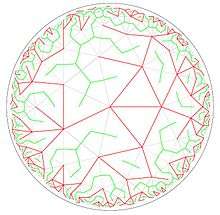
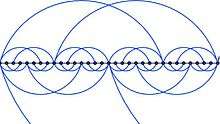
| Lattice | z | Site Percolation Threshold | Bond Percolation Threshold | ||
|---|---|---|---|---|---|
| Lower | Upper | ||||
| {4,5} hyperbolic | 5 | 5 | 0.27[150] | 0.52[150] | |
| {7,3} hyperbolic | 3 | 3 | 0.72[150] | 0.53[150] | |
| {3,7} hyperbolic | 7 | 7 | 0.20[150] | 0.37[150] | |
| {∞,3} Cayley tree | 3 | 3 | 1/2 | 1/2[150] | 1[150] |
| Enhanced binary tree (EBT) | 0.304(1)[150] | 0.48,[150] 0.564(1)[151] | |||
| Enhanced binary tree dual | 0.436(1)[151] | 0.696(1)[151] | |||
| Non-Planar Hanoi Network (HN-NP) | 0.319445[149] | 0.381996[149] | |||
| Cayley tree with grandparents | 8 | 0.158656326[152] | |||
Note: {m,n} is the Schläfli symbol, signifying a hyperbolic lattice in which n regular m-gons meet at every vertex
Cayley tree (Bethe lattice) with coordination number z: pc= 1 / (z - 1)
Cayley tree with a distribution of z with mean , mean-square pc= [153] (site or bond threshold)
Thresholds for directed percolation
D_Kagome_Lattice.png)
D_Square_Lattice.png)
D_Triangular_Lattice.png)
D_SC_Lattice.png)
D_BCC_Lattice.png)
| Lattice | z | Site Percolation Threshold | Bond Percolation Threshold |
|---|---|---|---|
| (1+1)-d honeycomb | 1.5 | 0.8399316(2),[154] 0.839933(5),[155] | 0.8228569(2),[154] 0.82285680(6)[154] |
| (1+1)-d kagome | 2 | 0.7369317(2),[154] 0.73693182(4)[156] | 0.6589689(2),[154] 0.65896910(8)[154] |
| (1+1)-d square, diagonal direction | 2 | 0.705489(4),[157] 0.70548522(4),[158] 0.70548515(20),[156]
0.7054852(3),[154] |
0.644701(2),[159] 0.644701(1),[160] 0.64470015(5),[161] 0.644700185(5),[158] 0.6447001(2),[154] |
| (1+1)-d triangular | 3 | 0.5956468(5),[161] 0.5956470(3) [154] | 0.478025(1),[161] 0.4780250(4) [154] |
| (2+1)-d simple cubic, diagonal planes | 3 | 0.43531(1) [162] | 0.382223(7) [162] |
| (2+1)-d square nn (= bcc) | 4 | 0.3445736(3),[163] 0.344575(15) [164] | 0.2873383(1),[165] 0.287338(3)[162] |
| (3+1)-d hypercubic, diagonal planes | 4 | 0.3025(10) [166] | |
| (3+1)-d cubic, nn | 6 | 0.2081040(4) [163] | 0.1774970(5) [107] |
| (3+1)-d body-centered hypercubic | 8 | 0.160950(30) [164] | |
| (4+1)-d hypercubic, nn | 8 | 0.1461593(2),[163] 0.1461582(3) [167] | 0.1288557(5) [107] |
| (4+1)-d body-centered hypercubic | 16 | 0.075582(17) [164]
0.0755850(3) [167] |
|
| (5+1)-d hypercubic, nn | 10 | 0.1123373(2) [163] | 0.1016796(5) [107] |
| (5+1)-d body-centered hypercubic | 32 | 0.035967(23) [164] | |
| (6+1)-d hypercubic, nn | 12 | 0.0913087(2) [163] | 0.0841997(14) [107] |
| (7+1)-d hypercubic,nn | 14 | 0.07699336(7) [163] | 0.07195(5) [107] |
nn = nearest neighbors. For a (d+1)-dimensional hypercubic system, the hypercube is in d dimensions and the time direction points to the 2D nearest neighbors.
Exact critical manifolds of inhomogeneous systems
Inhomogeneous triangular lattice bond percolation[14]
Inhomogeneous honeycomb lattice bond percolation = kagome lattice site percolation[14]
Inhomogeneous (3,12^2) lattice, site percolation[4] [168]
or
Inhomogeneous union-jack lattice, site percolation with probabilities [169]
Inhomogeneous martini lattice, bond percolation [45][170]
Inhomogeneous martini lattice, site percolation. r = site in the star
Inhomogeneous martini-A (3–7) lattice, bond percolation. Left side (top of "A" to bottom): . Right side: . Cross bond: .
Inhomogeneous martini-B (3–5) lattice, bond percolation
Inhomogeneous martini lattice with outside enclosing triangle of bonds, probabilities from inside to outside, bond percolation [170]
Inhomogeneous checkerboard lattice, bond percolation [34][62]
Inhomogeneous bow-tie lattice, bond percolation [33][62]
where are the four bonds around the square and is the diagonal bond connecting the vertex between bonds and .
Percolation thresholds for graphs
For random graphs not embedded in space the percolation threshold can be calculated exactly. For example, for random regular graphs where all nodes have the same degree k, pc=1/k. For Erdős–Rényi (ER) graphs with Poissonian degree distribution, pc=1/<k>.[171] The critical threshold was calculated exactly also for a network of interdependent ER networks.[172][173]
See also
- Continuum percolation
- Directed percolation
- Effective Medium Approximations
- Epidemic models on lattices
- Graph theory
- Uniform Tilings
- Network Science
- Percolation
- Percolation theory
- Percolation critical exponents
- 2D percolation cluster
References
- ↑ Kasteleyn, P. W.; C. M. Fortuin (1969). "Phase transitions in lattice systems with random local properties". Journal of the Physical Society of Japan (Supplements). 26: 11–14.
- 1 2 3 4 5 Grünbaum, Branko & Shephard, G. C. (1987). Tilings and Patterns. New York: W. H. Freeman. ISBN 0-7167-1193-1.
- 1 2 3 4 5 6 7 Parviainen, Robert (2005). Connectivity Properties of Archimedean and Laves Lattices. 34. Uppsala Dissertations in Mathematics. p. 37. ISBN 91-506-1751-6.
- 1 2 3 4 5 6 7 8 9 Suding, P. N.; R. M. Ziff (1999). "Site percolation thresholds for Archimedean lattices". Physical Review E. 60 (1): 275–283. Bibcode:1999PhRvE..60..275S. doi:10.1103/PhysRevE.60.275.
- 1 2 3 4 5 6 7 8 9 10 11 12 13 14 15 16 17 18 19 20 21 22 Jacobsen, J. L. (2014). "High-precision percolation thresholds and Potts-model critical manifolds from graph polynomials". J. Phys. A: Math. Theor. 47 (13): 135001. arXiv:1401.7847
 . Bibcode:2014JPhA...47m5001G. doi:10.1088/1751-8113/47/13/135001.
. Bibcode:2014JPhA...47m5001G. doi:10.1088/1751-8113/47/13/135001. - 1 2 Jacobsen, Jesper L.; Christian R. Scullard (2013). "Critical manifolds, graph polynomials, and exact solvability" (PDF). StatPhys 25, Seoul, Korea July 21–26.
- 1 2 Scullard, C. R.; J. L. Jacobsen (2012). "Transfer matrix computation of generalised critical polynomials in percolation". arXiv:1209.1451
 .
. - 1 2 3 4 5 6 7 Parviainen, Robert (2007). "Estimation of bond percolation thresholds on the Archimedean lattices". Journal of Physics A. 40 (31): 9253–9258. arXiv:0704.2098
 . Bibcode:2007JPhA...40.9253P. doi:10.1088/1751-8113/40/31/005.
. Bibcode:2007JPhA...40.9253P. doi:10.1088/1751-8113/40/31/005. - 1 2 3 4 5 6 7 8 9 Ding, Chengxiang; Zhe Fu. Wenan Guo; F. Y. Wu (2010). "Critical frontier for the Potts and percolation models on triangular-type and kagome-type lattices II: Numerical analysis". Physical Review E. 81 (6): 061111. arXiv:1001.1488
 . Bibcode:2010PhRvE..81f1111D. doi:10.1103/PhysRevE.81.061111.
. Bibcode:2010PhRvE..81f1111D. doi:10.1103/PhysRevE.81.061111. - 1 2 Schliecker, G.; C. Kaiser (1999). "Percolation on disordered mosaics". Physica A. 269: 189–200. Bibcode:1999PhyA..269..189S. doi:10.1016/S0378-4371(99)00093-X.
- ↑ Djordjevic, Z. V.; H. E. Stanley; Alla Margolina (1982). "Site percolation threshold for honeycomb and square lattices". Journal of Physics A. 15: L405–L412. Bibcode:1982JPhA...15L.405D. doi:10.1088/0305-4470/15/8/006.
- 1 2 3 4 Feng, Xiaomei; Youjin Deng; Henk W. J. Blote (2008). "Percolation transitions in two dimensions". Physical Review E. 78 (3): 031136. Bibcode:2008PhRvE..78c1136F. doi:10.1103/PhysRevE.78.031136.
- 1 2 3 4 5 6 7 Ziff, R. M.; Hang Gu (2008). "Universal relation for critical percolation thresholds of kagome-class lattices".
- 1 2 3 4 5 Sykes, M. F.; J. W. Essam (1964). "Exact critical percolation probabilities for site and bond problems in two dimensions". Journal of Mathematical Physics. 5 (8): 1117–1127. Bibcode:1964JMP.....5.1117S. doi:10.1063/1.1704215.
- ↑ Scullard, C. R. (2012). "Percolation critical polynomial as a graph invariant". Physical Review E. 86 (4): 1131. arXiv:1111.1061
 . Bibcode:2012PhRvE..86d1131S. doi:10.1103/PhysRevE.86.041131.
. Bibcode:2012PhRvE..86d1131S. doi:10.1103/PhysRevE.86.041131. - ↑ Ziff, R. M.; P. W. Suding (1997). "Determination of the bond percolation threshold for the kagome lattice". Journal of Physics A. 30 (15): 5351–5359. arXiv:cond-mat/9707110
 . Bibcode:1997JPhA...30.5351Z. doi:10.1088/0305-4470/30/15/021.
. Bibcode:1997JPhA...30.5351Z. doi:10.1088/0305-4470/30/15/021. - 1 2 Jacobsen, J. L. (2015). "Critical points of Potts and O(N) models from eigenvalue identities in periodic Temperley-Lieb algebras". Preprint. arXiv:1507.03027
 . Bibcode:2015JPhA...48S4003L. doi:10.1088/1751-8113/48/45/454003.
. Bibcode:2015JPhA...48S4003L. doi:10.1088/1751-8113/48/45/454003. - ↑ Lin, Keh Ying; Wen Jong Ma (1983). "Two-dimensional Ising model on a ruby lattice". Journal of Physics A. 16 (16): 3895–3898. Bibcode:1983JPhA...16.3895L. doi:10.1088/0305-4470/16/16/027.
- ↑ Yang, Y.; S. Zhou.; Y. Li. (2013). "Square++: Making a connection game win-lose complementary and playing-fair". Entertainment Computing. 4 (2): 105–113. doi:10.1016/j.entcom.2012.10.004.
- ↑ Newman, M. E. J.; R. M. Ziff (2000). "Efficient Monte-Carlo algorithm and high-precision results for percolation". Physical Review Letters. 85 (19): 4104–7. arXiv:cond-mat/0005264
 . Bibcode:2000PhRvL..85.4104N. doi:10.1103/PhysRevLett.85.4104. PMID 11056635.
. Bibcode:2000PhRvL..85.4104N. doi:10.1103/PhysRevLett.85.4104. PMID 11056635.
- ↑ de Oliveira, P.M.C.; R. A. Nobrega, D. Stauffer. (2003). "Corrections to finite size scaling in percolation". Brazilian Journal of Physics. 33 (3): 616–618. doi:10.1590/S0103-97332003000300025.
- ↑ Lee, M. J. (2007). "Complementary algorithms for graphs and percolation". Physical Review E. 76 (2): 027702. arXiv:0708.0600
 . Bibcode:2007PhRvE..76b7702L. doi:10.1103/PhysRevE.76.027702.
. Bibcode:2007PhRvE..76b7702L. doi:10.1103/PhysRevE.76.027702.
- ↑ Lee, M. J. (2008). "Pseudo-random-number generators and the square site percolation threshold". Physical Review E. 78 (3): 031131. arXiv:0807.1576
 . Bibcode:2008PhRvE..78c1131L. doi:10.1103/PhysRevE.78.031131.
. Bibcode:2008PhRvE..78c1131L. doi:10.1103/PhysRevE.78.031131.
- ↑ Levenshteĭn, M. E.; B. I. Shklovskiĭ; M. S. Shur; A. L. Éfros (1975). "The relation between the critical exponents of percolation theory". Zh. Eksp. Teor. Fiz. 69: 386–392.,
- ↑ Dean, P; N. F. Bird (1967). "Monte Carlo estimates of critical percolation probabilities". Proc. Camb. Phil. Soc. 63: 477–479.,
- ↑ Dean, P (1963). "A new Monte Carlo method for percolation problems on a lattice". Proc. Camb. Phil. Soc. 59: 397–410.,
- ↑ Betts, D. D. (1995). "A new two-dimensional lattice of coordination number five". Proc. Nova Scotian. Inst. Sci. 40: 95–100.
- 1 2 3 4 5 6 7 8 9 10 11 12 13 14 15 16 17 18 19 20 21 22 23 van der Marck, S. C. (1997). "Percolation thresholds and universal formulas". Physical Review E. 55 (2): 1514–1517. Bibcode:1997PhRvE..55.1514V. doi:10.1103/PhysRevE.55.1514.
- 1 2 3 4 Malarz, K.; S. Galam (2005). "Square-lattice site percolation at increasing ranges of neighbor bonds". Physical Review E. 71 (1): 016125. arXiv:cond-mat/0408338
 . Bibcode:2005PhRvE..71a6125M. doi:10.1103/PhysRevE.71.016125.
. Bibcode:2005PhRvE..71a6125M. doi:10.1103/PhysRevE.71.016125.
- 1 2 3 4 5 6 7 8 9 10 11 12 13 14 15 16 17 18 19 20 21 22 23 24 25 26 Majewski, M.; K. Malarz (2007). "Square lattice site percolation thresholds for complex neighbourhoods". Acta Phys. Pol. B. 38 (38): 2191. arXiv:cond-mat/0609635
 . Bibcode:2007AcPPB..38.2191M.
. Bibcode:2007AcPPB..38.2191M.
- ↑ Collier, Andrew. "Percolation Threshold: Including Next-Nearest Neighbours".
- 1 2 3 4 Koza, Zbigniew; Kondrat, Grzegorz; Suszczyński, Karol (2014). "Percolation of overlapping squares or cubes on a lattice". J. Stat. Mech.: Th. Exp. 2014 (11): P11005. Bibcode:2014JSMTE..11..005K. doi:10.1088/1742-5468/2014/11/P11005. Retrieved 2014-11-11.
- 1 2 3 Scullard, C. R.; R. M. Ziff (2010). "Critical surfaces for general inhomogeneous bond percolation problems". J. Stat. Mech: Th. Exp. 2010 (3): P03021. arXiv:0911.2686
 . Bibcode:2010JSMTE..03..021S. doi:10.1088/1742-5468/2010/03/P03021.
. Bibcode:2010JSMTE..03..021S. doi:10.1088/1742-5468/2010/03/P03021.
- 1 2 Wu, F. Y. (1979). "Critical point of planar Potts models". Journal of Physics C. 12 (17): L645–L650. Bibcode:1979JPhC...12L.645W. doi:10.1088/0022-3719/12/17/002.
- ↑ Scullard, C. R. (2010). To be published. Missing or empty
|title=(help) - 1 2 3 4 5 Sakamoto, S.; F. Yonezawa and M. Hori (1989). "A proposal for the estimation of percolation thresholds in two-dimensional lattices". J. Phys. A. 22 (14): L699–L704. Bibcode:1989JPhA...22L.699S. doi:10.1088/0305-4470/22/14/009.
- ↑ Deng, Y.; Y. Huang, J. L. Jacobsen, J. Salas, and A. D. Sokal, (2006). "Finite-temperature phase transition in a class of four-state Potts antiferromagnets". Physical Review Letters. 107: 150601. arXiv:1108.1743
 . Bibcode:2011PhRvL.107o0601D. doi:10.1103/PhysRevLett.107.150601.
. Bibcode:2011PhRvL.107o0601D. doi:10.1103/PhysRevLett.107.150601.
- ↑ Syozi, I (1972). "Transformation of Ising Models". In Domb, C.; Green, M. S. Phase Transitions in Critical Phenomena. 1. Academic Press, London. pp. 270–329.
- 1 2 3 4 5 6 7 Hovi, J.-P.; A. Aharony (1996). "Scaling and universality in the spanning probability for percolation". Physical Review E. 53 (1): 235–253. Bibcode:1996PhRvE..53..235H. doi:10.1103/PhysRevE.53.235.
- 1 2 3 4 5 6 7 8 9 10 11 12 13 14 15 16 17 18 19 20 21 Neher, Richard; Mecke, Klaus and Wagner, Herbert (2008). "Topological estimation of percolation thresholds". Journal of Statistical Mechanics: Theory and Experiment. 2008: P01011. arXiv:0708.3250
 . Bibcode:2008JSMTE..01..011N. doi:10.1088/1742-5468/2008/01/P01011.
. Bibcode:2008JSMTE..01..011N. doi:10.1088/1742-5468/2008/01/P01011.
- 1 2 3 4 5 6 7 8 9 10 11 12 13 14 15 16 17 18 19 20 Gu, Hang; R. M. Ziff (2007). "Percolation thresholds of 2-uniform lattice". To be published.
- ↑ Grimmett, G.; Manolescu, I. "Bond percolation on isoradial graphs". arXiv:1204.0505
 .
. - 1 2 Scullard, C. R. (2006). "Exact site percolation thresholds using a site-to-bond transformation and the star-triangle transformation". Physical Review E. 73: 016107. arXiv:cond-mat/0507392
 . Bibcode:2006PhRvE..73a6107S. doi:10.1103/PhysRevE.73.016107.
. Bibcode:2006PhRvE..73a6107S. doi:10.1103/PhysRevE.73.016107.
- 1 2 3 Ziff, R. M. (2006). "Generalized cell–dual-cell transformation and exact thresholds for percolation". Physical Review E. 73: 016134. Bibcode:2006PhRvE..73a6134Z. doi:10.1103/PhysRevE.73.016134.
- 1 2 3 4 5 6 7 8 9 10 11 12 13 Scullard, C. R.; Robert M Ziff (2006). "Exact bond percolation thresholds in two dimensions". Journal of Physics A. 39 (49): 15089. arXiv:cond-mat/0610813
 . Bibcode:2006JPhA...3915083Z. doi:10.1088/0305-4470/39/49/003.
. Bibcode:2006JPhA...3915083Z. doi:10.1088/0305-4470/39/49/003.
- 1 2 Gu, Hang; A. Becker; R. M. Ziff (2009). "Percolation on the Voronoi covering/medial diagram and several other four-coordinated lattices". To be published.
- 1 2 Ziff, R. M. (2013). To be published. Missing or empty
|title=(help) - ↑ Ziff, R. M.; Scullard, C. R. (2010). "Critical surfaces for general inhomogeneous bond percolation problems". J. Stat. Mech. 2010 (3): P03021. arXiv:0911.2686
 . Bibcode:2010JSMTE..03..021S. doi:10.1088/1742-5468/2010/03/P03021.
. Bibcode:2010JSMTE..03..021S. doi:10.1088/1742-5468/2010/03/P03021.
- 1 2 3 4 5 6 7 8 9 10 11 12 13 14 Melchert, Oliver; Helmut G. Katzgraber; Mark A. Novotny (2015). "Site and bond percolation thresholds in Kn,n-based lattices: Vulnerability of quantum annealers to random qubit and coupler failures on Chimera topologies". arXiv:1511.07078
 .
. - ↑ Okubo, S.; M. Hayashi, S. Kimura, H. Ohta, M. Motokawa, H. Kikuchi and H. Nagasawa (1998). "Submillimeter wave ESR of triangular-kagome antiferromagnet Cu9X2(cpa)6 (X=Cl, Br)". Physica B. 246--247 (2): 553–556. Bibcode:1998PhyB..246..553O. doi:10.1016/S0921-4526(97)00985-X.
- 1 2 3 4 5 6 7 8 9 10 11 Haji Akbari, Amir; R. M. Ziff (2009). "Percolation in networks with voids and bottlenecks". Physical Review E. 79 (2): 021118. arXiv:0811.4575
 . Bibcode:2009PhRvE..79b1118H. doi:10.1103/PhysRevE.79.021118.
. Bibcode:2009PhRvE..79b1118H. doi:10.1103/PhysRevE.79.021118.
- 1 2 3 Gu, Hang; R. M. Ziff (2010). To be published. Missing or empty
|title=(help) - 1 2 Cherkasova, V. A.; Yu. Yu. Tarasevich; N. I. Lebovka; and N.V. Vygornitskii (2010). "Percolation of the aligned dimers on a square lattice". Eur. Phys. J. B. 74 (2): 205–209. arXiv:0912.0778
 . Bibcode:2010EPJB...74..205C. doi:10.1140/epjb/e2010-00089-2.
. Bibcode:2010EPJB...74..205C. doi:10.1140/epjb/e2010-00089-2.
- 1 2 3 4 5 6 7 Vanderwalle, N.; S. Galam; M. Kramer (2000). "A new universality for random sequential deposition of needles". Eur. Phys. J. B. 14 (3): 407–410. doi:10.1007/s100510051047.
- ↑ Cornette, V.; A. J. Ramirez-Pastor; F. Nieto (2003). "Dependenceofthepercolationthresholdonthe sizeofthepercolatingspecies". Physica A. 327: 71–75. doi:10.1016/S0378-4371(03)00453-9.
- 1 2 3 4 Budinski-Petkovic, Lj; I. Loncarevic; Z. M. Jacsik; and S. B. Vrhovac (2016). "Jamming and percolation in random sequential adsorption of extended objects on a triangular lattice with quenched impurities". J. Stat. Mech.: Th. Exp. 2016: 053101. doi:10.1088/1742-5468/2016/05/053101.
- ↑ Kondrat, Grzegorz; Andrzej Pękalski (2001). "Percolation and jamming in random sequential adsorption of linear segments on a square lattice". Phys. Rev. E. 63 (5): 051108. doi:10.1103/PhysRevE.63.051108.
- 1 2 3 4 5 6 7 Haji-Akbari, A.; Nasim Haji-Akbari; Robert M. Ziff (2015). "Dimer Covering and Percolation Frustration". Phys. Rev. E. 92: 032134. arXiv:1507.04411
 . Bibcode:2015PhRvE..92c2134H. doi:10.1103/PhysRevE.92.032134.
. Bibcode:2015PhRvE..92c2134H. doi:10.1103/PhysRevE.92.032134.
- ↑ Zia, R. K. P.; W. Yong; B. Schmittmann (2009). "Percolation of a collection of finite random walks: a model for gas permeation through thin polymeric membranes". Journal of Mathematical Chemistry. 45: 58–64. doi:10.1007/s10910-008-9367-6.
- 1 2 3 4 Wu, Yong; B. Schmittmann; R. K. P. Zia (2008). "Two-dimensional polymer networks near percolation". Journal of Physics A. 41 (2): 025008. Bibcode:2008JPhA...41b5004W. doi:10.1088/1751-8113/41/2/025004.
- 1 2 3 4 5 6 7 8 9 10 11 12 13 14 15 16 17 18 19 20 21 22 23 24 25 26 27 28 29 30 Cornette, V.; A.J. Ramirez-Pastor, F. Nieto (2003). "Two-dimensional polymer networks near percolation". European Physical Journal B. 36 (3): 397. Bibcode:2003EPJB...36..391C. doi:10.1140/epjb/e2003-00358-1.
- 1 2 3 Ziff, R. M.; C. R. Scullard; J. C. Wierman; M. R. A. Sedlock (2012). "The critical manifolds of inhomogeneous bond percolation on bow-tie and checkerboard lattices". Journal of Physics A: Mathematical and Theoretical. 45 (49): 494005. arXiv:1210.6609
 . Bibcode:2012JPhA...45W4005Z. doi:10.1088/1751-8113/45/49/494005.
. Bibcode:2012JPhA...45W4005Z. doi:10.1088/1751-8113/45/49/494005.
- 1 2 3 Quintanilla, John A.; R. M. Ziff (2007). "Near symmetry of percolation thresholds of fully penetrable disks with two different radii". Physical Review E. 76 (5): 051115 [6 pages]. Bibcode:2007PhRvE..76e1115Q. doi:10.1103/PhysRevE.76.051115.
- 1 2 3 Quintanilla, J; S. Torquato; R. M. Ziff (2000). "Efficient measurement of the percolation threshold for fully penetrable discs". J. Phys. A: Math. Gen. 33 (42): L399–L407. Bibcode:2000JPhA...33L.399Q. doi:10.1088/0305-4470/33/42/104.
- 1 2 3 4 5 6 7 8 9 10 Mertens, Stephan; Cristopher Moore (2012). "Continuum percolation thresholds in two dimensions". Physical Review E. 86: 061109. arXiv:1209.4936
 . Bibcode:2012PhRvE..86f1109M. doi:10.1103/PhysRevE.86.061109.
. Bibcode:2012PhRvE..86f1109M. doi:10.1103/PhysRevE.86.061109.
- 1 2 Xia, W.; M. F. Thorpe (1988). "Percolation properties of random ellipses". Physical Review A. 38 (5): 2650–2656. Bibcode:1988PhRvA..38.2650X. doi:10.1103/PhysRevA.38.2650. PMID 9900674.
- 1 2 3 4 5 6 Yi, Y.-B.; A. M. Sastry (2004). "Analytical approximation of the percolation threshold for overlapping ellipsoids of revolution". Proceedings of the Royal Society A. 460 (5): 2353–2380. Bibcode:2004RSPSA.460.2353Y. doi:10.1098/rspa.2004.1279.
- 1 2 3 4 5 6 7 8 9 10 11 12 13 Torquato, S.; Y. Jiao (2012). "Effect of dimensionality on the continuum percolation of overlapping hyperspheres and hypercubes. II. Simulation results and analyses". J. Chem. Phys. 137 (7): 074106. arXiv:1208.3720
 . Bibcode:2012JChPh.137g4106T. doi:10.1063/1.4742750.
. Bibcode:2012JChPh.137g4106T. doi:10.1063/1.4742750.
- 1 2 3 4 5 6 7 8 9 10 Baker, Don R.; Gerald Paul; Sameet Sreenivasan; H. Eugene Stanley (2002). "Continuum percolation threshold for interpenetrating squares and cubes". Physical Review E. 66 (4): 046136 [5 pages]. arXiv:cond-mat/0203235
 . Bibcode:2002PhRvE..66d6136B. doi:10.1103/PhysRevE.66.046136.
. Bibcode:2002PhRvE..66d6136B. doi:10.1103/PhysRevE.66.046136.
- 1 2 3 4 5 6 7 8 9 10 11 12 13 14 Li, Jiantong; Mikael Östling (2013). "Percolation thresholds of two-dimensional continuum systems of rectangles". Physical Review E. 88 (1): 012101. Bibcode:2013PhRvE..88a2101L. doi:10.1103/PhysRevE.88.012101.
- ↑ Li, Jiantong; Shi-Li Zhang (2009). "Finite-size scaling in stick percolation". Physical Review E. 80 (4): 040104(R). Bibcode:2009PhRvE..80d0104L. doi:10.1103/PhysRevE.80.040104.
- 1 2 3 4 5 6 7 8 9 Sasidevan, V. (2013). "Continuum percolation of overlapping discs with a distribution of radii having a power-law tail". arXiv:1302.0085
 .
.
- 1 2 van der Marck, S. C. (1996). "Network Approach to Void Percolation in a Pack of Unequal Spheres". Physical Review Letters. 77 (9): 1785–1788. Bibcode:1996PhRvL..77.1785V. doi:10.1103/PhysRevLett.77.1785. PMID 10063171.
- 1 2 3 4 5 6 7 Jin, Yuliang; Patrick Charbonneau (2014). "Mapping the arrest of the random Lorentz gas onto the dynamical transition of a simple glass former". preprint. arXiv:1409.0688
 . Bibcode:2015PhRvE..91d2313J. doi:10.1103/PhysRevE.91.042313.
. Bibcode:2015PhRvE..91d2313J. doi:10.1103/PhysRevE.91.042313.
- 1 2 3 Melchert, Oliver (2013). "Percolation thresholds on planar Euclidean relative-neighborhood graphs". Physical Review E. 87 (4): 042106. arXiv:1301.6967
 . Bibcode:2013PhRvE..87d2106M. doi:10.1103/PhysRevE.87.042106.
. Bibcode:2013PhRvE..87d2106M. doi:10.1103/PhysRevE.87.042106.
- 1 2 3 4 5 Becker, A.; R. M. Ziff (2009). "Percolation thresholds on two-dimensional Voronoi networks and Delaunay triangulations". Physical Review E. 80 (4): 041101. arXiv:0906.4360
 . Bibcode:2009PhRvE..80d1101B. doi:10.1103/PhysRevE.80.041101.
. Bibcode:2009PhRvE..80d1101B. doi:10.1103/PhysRevE.80.041101.
- ↑ Shante, K. S.; S. Kirkpatrick (1971). "An introduction to percolation theory". Advances in Physics. 20 (85): 325–357. Bibcode:1971AdPhy..20..325S. doi:10.1080/00018737100101261.
- 1 2 3 Hsu, H. P.; M. C. Huang (1999). "Percolation thresholds, critical exponents, and scaling functions on planar random lattices and their duals". Physical Review E. 60 (1999): 6361–6370. Bibcode:1999PhRvE..60.6361H. doi:10.1103/PhysRevE.60.6361.
- 1 2 Norrenbrock, C. (2014). "Percolation threshold on planar Euclidean Gabriel Graphs". Journal of Physics A. 40: 9253. arXiv:0704.2098
 . Bibcode:2007JPhA...40.9253P. doi:10.1088/1751-8113/40/31/005.
. Bibcode:2007JPhA...40.9253P. doi:10.1088/1751-8113/40/31/005. - 1 2 Bertin, E; J.-M. Billiot, R. Drouilhet (2002). "Continuum percolation in the Gabriel graph". Adv. Appl. Prob. 34: 689. doi:10.1239/aap/1037990948.
- ↑ Lepage, Thibaut; Lucie Delaby; Fausto Malvagi; Alain Mazzolo (2011). "Monte Carlo simulation of fully Markovian stochastic geometries". Progress in Nuclear Science and Technology. 2: 743–748.
- ↑ Ziff, R. M.; F. Babalievski (1999). "Site percolation on the Penrose rhomb lattice". Physica A. 269 (2–4): 201–210. Bibcode:1999PhyA..269..201Z. doi:10.1016/S0378-4371(99)00166-1.
- 1 2 3 4 5 6 7 8 Babalievski, F. (1995). "Percolation thresholds and percolation conductivities of octagonal and dodecagonal quasicrystalline lattices". Physica A. 220 (1995): 245–250. Bibcode:1995PhyA..220..245B. doi:10.1016/0378-4371(95)00260-E.
- ↑ Bollobás, Béla; Oliver Riordan (2006). "The critical probability for random Voronoi percolation in the plane is 1/2". Probab. Theory Relat. Fields. 136 (3): 417–468. doi:10.1007/s00440-005-0490-z.
- 1 2 3 4 Sotta, P.; D. Long (2003). "The crossover from 2D to 3D percolation: Theory and numerical simulations". Eur. Phys. J. E. 11 (4): 375–388. Bibcode:2003EPJE...11..375S. doi:10.1140/epje/i2002-10161-6.
- 1 2 3 4 5 6 7 Gliozzi, F.; S. Lottini; M. Panero; A. Rago (2005). "Random percolation as a gauge theory". Nuclear Physics B. 719 (3): 255–274. arXiv:cond-mat/0502339
 . Bibcode:2005NuPhB.719..255G. doi:10.1016/j.nuclphysb.2005.04.021.
. Bibcode:2005NuPhB.719..255G. doi:10.1016/j.nuclphysb.2005.04.021.
- 1 2 3 4 5 6 7 8 Yoo, Ted Y.; Jonathan Tran; Shane P. Stahlheber; Carina E. Kaainoa; Kevin Djepang; Alexander R. Small (2014). "Site percolation on lattices with low average coordination numbers". J. Stat. Mech. Th. Exp. 2014: P06014. arXiv:1403.1676
 . Bibcode:2014JSMTE..06..014Y. doi:10.1088/1742-5468/2014/06/p06014.
. Bibcode:2014JSMTE..06..014Y. doi:10.1088/1742-5468/2014/06/p06014.
- 1 2 3 4 5 6 7 8 9 Tran, Jonathan; Ted Yoo; Shane Stahlheber; Alex Small (2013). "Percolation thresholds on 3-dimensional lattices with 3 nearest neighbors". J. Stat. Mech. Th. Exp. 2013: P05014. arXiv:1211.6531
 . Bibcode:2013JSMTE..05..014T. doi:10.1088/1742-5468/2013/05/P05014.
. Bibcode:2013JSMTE..05..014T. doi:10.1088/1742-5468/2013/05/P05014.
- 1 2 3 4 5 6 7 8 9 10 van der Marck, S. C. (1997). "Percolation thresholds of the duals of the face-centered-cubic, hexagonal-close-packed, and diamond lattices". Phys. Rev. E. 55 (6): 6593–6597. doi:10.1103/PhysRevE.55.6593.
- 1 2 Frisch, H. L.; E. Sonnenblick; V. A. Vyssotsky; J. M. Hammersley (1961). "Critical Percolation Probabilities (Site Problem)". Physical Review. 124 (4): 1021–1022. Bibcode:1961PhRv..124.1021F. doi:10.1103/PhysRev.124.1021.
- 1 2 Vyssotsky, V. A.; S. B. Gordon; H. L. Frisch; J. M. Hammersley (1961). "Critical Percolation Probabilities (Bond Problem)". Physical Review. 123 (5): 1566–1567. Bibcode:1961PhRv..123.1566V. doi:10.1103/PhysRev.123.1566.
- 1 2 3 4 Xu, Xiao; Junfeng Wang, Jian-Ping Lv, Youjin Deng (2014). "Simultaneous analysis of three-dimensional percolation models". Frontiers of Physics. 9 (1): 113–119. arXiv:1310.5399v1
 . Bibcode:2014FrPhy...9..113X. doi:10.1007/s11467-013-0403-z.
. Bibcode:2014FrPhy...9..113X. doi:10.1007/s11467-013-0403-z. - ↑ Silverman, Amihal; J. Adler (1990). "Site-percolation threshold for a diamond lattice with diatomic substitution". Physical Review B. 42 (2): 1369–1373. Bibcode:1990PhRvB..42.1369S. doi:10.1103/PhysRevB.42.1369.
- 1 2 3 4 5 6 7 8 9 10 11 12 13 14 15 van der Marck, Steven C. (1998). "Calculation of Percolation Thresholds in High Dimensions for FCC, BCC and Diamond Lattices". International Journal of Modern Physics C. 9 (4): 529–540. arXiv:cond-mat/9802187
 . Bibcode:1998IJMPC...9..529V. doi:10.1142/S0129183198000431.
. Bibcode:1998IJMPC...9..529V. doi:10.1142/S0129183198000431. - 1 2 Sykes, M. F.; D. S. Gaunt; M. Glen (1976). "Percolation processes in three dimensions". J. Phys. A: Math. Gen. 9 (10): 1705–1712.
- 1 2 3 4 5 6 7 8 Sykes, M. F.; J. W. Essam (1964). "Critical percolation probabilities by series method". Physical Review. 133 (1A): A310–A315. Bibcode:1964PhRv..133..310S. doi:10.1103/PhysRev.133.A310.
- 1 2 3 4 van der Marck, Steven C. (1998). "Site percolation and random walks on d-dimensional Kagome lattices". Journal of Physics A. 31 (15): 3449–3460. arXiv:cond-mat/9801112v1
 . Bibcode:1998JPhA...31.3449V. doi:10.1088/0305-4470/31/15/010.
. Bibcode:1998JPhA...31.3449V. doi:10.1088/0305-4470/31/15/010.
- ↑ Sur, Amit; Joel L. Lebowitz; J. Marro; M. H. Kalos; S. Kirkpatrick (1976). "Monte Carlo studies of percolation phenomena for a simple cubic lattice". Journal of Statistical Physics. 15 (5): 345–353. doi:10.1007/BF01020338.
- 1 2 Wang, J; Z. Zhou; W. Zhang; T. Garoni; Y. Deng (2013). "Bond and site percolation in three dimensions". arXiv:1302.0421
 . Bibcode:2013PhRvE..87e2107W. doi:10.1103/PhysRevE.87.052107.
. Bibcode:2013PhRvE..87e2107W. doi:10.1103/PhysRevE.87.052107. - ↑ Grassberger, P. (1992). "Numerical studies of critical percolation in three dimensions". J. Phys. A. 25 (22): 5867–5888. Bibcode:1992JPhA...25.5867G. doi:10.1088/0305-4470/25/22/015.
- ↑ Acharyya, M.; D. Stauffer (1998). "Effects of Boundary Conditions on the Critical Spanning Probability". Int. J. Mod. Phys. C. 9 (4): 643–647. arXiv:cond-mat/9805355
 . Bibcode:1998IJMPC...9..643A. doi:10.1142/S0129183198000534.
. Bibcode:1998IJMPC...9..643A. doi:10.1142/S0129183198000534.
- ↑ Jan, N.; D. Stauffer (1998). "Random Site Percolation in Three Dimensions". Int. J. Mod. Phys. C. 9 (4): 341–347. Bibcode:1998IJMPC...9..341J. doi:10.1142/S0129183198000261.
- ↑ Deng, Youjin; H. W. J. Blöte (2005). "Monte Carlo study of the site-percolation model in two and three dimensions". Physical Review E. 72 (1): 016126. Bibcode:2005PhRvE..72a6126D. doi:10.1103/PhysRevE.72.016126.
- ↑ Ballesteros, P. N.; L. A. Fernández, V. Martín-Mayor, A. Muñoz, Sudepe, G. Parisi, and J. J. Ruiz-Lorenzo (1999). "Scaling corrections: site percolation and Ising model in three dimensions". Journal of Physics A. 32: 1–13. arXiv:cond-mat/9805125
 . Bibcode:1999JPhA...32....1B. doi:10.1088/0305-4470/32/1/004.
. Bibcode:1999JPhA...32....1B. doi:10.1088/0305-4470/32/1/004.
- 1 2 3 Lorenz, C. D.; R. M. Ziff (1998). "Universality of the excess number of clusters and the crossing probability function in three-dimensional percolation". Journal of Physics A. 31 (40): 8147–8157. arXiv:cond-mat/9806224
 . Bibcode:1998JPhA...31.8147L. doi:10.1088/0305-4470/31/40/009.
. Bibcode:1998JPhA...31.8147L. doi:10.1088/0305-4470/31/40/009.
- ↑ Škvor, Jiří; Ivo Nezbeda (2009). "Percolation threshold parameters of fluids". Physical Review E. 79 (4): 041141. Bibcode:2009PhRvE..79d1141S. doi:10.1103/PhysRevE.79.041141.
- 1 2 3 4 5 6 7 8 Dammer, Stephan M; Haye Hinrichsen (2004). "Spreading with immunization in high dimensions". J. Stat. Mech: Theory Exp. 2004 (7): P07011. arXiv:cond-mat/0405577
 . Bibcode:2004JSMTE..07..011D. doi:10.1088/1742-5468/2004/07/P07011.
. Bibcode:2004JSMTE..07..011D. doi:10.1088/1742-5468/2004/07/P07011.
- 1 2 3 Lorenz, C. D.; R. M. Ziff (1998). "Precise determination of the bond percolation thresholds and finite-size scaling corrections for the sc, fcc, and bcc lattices". Physical Review E. 57: 230–236. arXiv:cond-mat/9710044
 . Bibcode:1998PhRvE..57..230L. doi:10.1103/PhysRevE.57.230.
. Bibcode:1998PhRvE..57..230L. doi:10.1103/PhysRevE.57.230. - 1 2 Schrenk, K. J.; N. A. M. Araújo; H. J. Herrmann (2013). "Stacked triangular lattice: percolation properties". Physical Review E. 87: 032123. arXiv:1302.0484
 . Bibcode:2013PhRvE..87c2123S. doi:10.1103/PhysRevE.87.032123.
. Bibcode:2013PhRvE..87c2123S. doi:10.1103/PhysRevE.87.032123. - ↑ Martins, P.; J. Plascak (2003). "Percolation on two- and three- dimensional lattices". Physical Review. 67. Bibcode:2003PhRvE..67d6119M. doi:10.1103/physreve.67.046119.
- ↑ Bradley, R. M.; P. N. Strenski, J.-M. Debierre (1991). "Surfaces of percolation clusters in three dimensions". Physical Review B. 44 (1): 76–84. Bibcode:1991PhRvB..44...76B. doi:10.1103/PhysRevB.44.76.
- ↑ Gaunt, D. S.; M. F. Sykes (1983). "Series study of random percolation in three dimensions". J. Phys. A. 16 (4): 783. Bibcode:1983JPhA...16..783G. doi:10.1088/0305-4470/16/4/016.
- 1 2 3 4 5 6 Kurzawski, Ł.; K. Malarz (2012). "Simple cubic random-site percolation thresholds for complex neighbourhoods". Rep. Math. Phys. 70 (2): 163–169. arXiv:1111.3254v2
 . Bibcode:2012RpMP...70..163K. doi:10.1016/S0034-4877(12)60036-6.
. Bibcode:2012RpMP...70..163K. doi:10.1016/S0034-4877(12)60036-6.
- 1 2 3 4 5 6 7 Malarz, Krzysztof (2015). "Simple cubic random-site percolation thresholds for neighborhoods containing fourth-nearest neighbors". Phys. Rev. E. 91 (4): 043301. arXiv:1501.01586
 . Bibcode:2015PhRvE..91d3301M. doi:10.1103/PhysRevE.91.043301.
. Bibcode:2015PhRvE..91d3301M. doi:10.1103/PhysRevE.91.043301.
- ↑ Sykes, M. F.; D. S. Gaunt; J. W. Essam (1976). "The percolation probability for the site problem on the face-centred cubic lattice". Journal of Physics A: Mathematical and General. 9 (5): L43–L46. Bibcode:1976JPhA....9L..43S. doi:10.1088/0305-4470/9/5/002.
- 1 2 Lorenz, C. D.; R. May; R. M. Ziff (2000). "Similarity of Percolation Thresholds on the HCP and FCC Lattices". Journal of Statistical Physics. 98 (3/4): 961–970. doi:10.1023/A:1018648130343.
- ↑ Tahir-Kheli, Jamil; W. A. Goddard III (2007). "Chiral plaquette polaron theory of cuprate superconductivity". Physical Review B. 76: 014514. arXiv:0707.3535
 . Bibcode:2007PhRvB..76a4514T. doi:10.1103/PhysRevB.76.014514.
. Bibcode:2007PhRvB..76a4514T. doi:10.1103/PhysRevB.76.014514.
- 1 2 3 4 Jerauld, G. R.; L. E. Scriven; H. T. Davis (1984). "Percolation and conduction on the 3D Voronoi and regular networks: a second case study in topological disorder". J. Phys. C: Solid State Phys. 17: 3429–3439. Bibcode:1984JPhC...17.3429J. doi:10.1088/0022-3719/17/19/017.
- 1 2 Ziff, R. M.; S. Torquato (2007). To be published. Missing or empty
|title=(help) - ↑ Harter, T. (2005). "Finite-size scaling analysis of percolation in three-dimensional correlated binary Markov chain random fields". Physical Review E. 72 (2): 026120. Bibcode:2005PhRvE..72b6120H. doi:10.1103/PhysRevE.72.026120.
- ↑ Sykes, M. F.; J. J. Rehr; Maureen Glen (1996). "A note on the percolation probabilities of pairs of closely similar lattices". Proc. Camb. Phil. Soc. 76: 389–392.
- ↑ Weber, H.; W. Paul (1996). "Penetrant diffusion in frozen polymer matrices: A finite-size scaling study of free volume percolation". Physical Review E. 54 (4): 3999. Bibcode:1996PhRvE..54.3999W. doi:10.1103/PhysRevE.54.3999.
- ↑ Tarasevich, Yu. Yu.; V. A. Cherkasova (2007). "Dimer percolation and jamming on simple cubic lattice". European Physical Journal B. 60 (1): 97–100. arXiv:0709.3626
 . Bibcode:2007EPJB...60...97T. doi:10.1140/epjb/e2007-00321-2.
. Bibcode:2007EPJB...60...97T. doi:10.1140/epjb/e2007-00321-2.
- 1 2 Rintoul, M. D.; S. Torquato (1997). "Precise determination of the critical threshold and exponents in a three-dimensional continuum percolation model". J. Phys. A: Math. Gen. 30: L585. Bibcode:1997JPhA...30L.585R. doi:10.1088/0305-4470/30/16/005.
- 1 2 Lorenz, C. D.; R. M. Ziff (2000). "Precise determination of the critical percolation threshold for the three dimensional Swiss cheese model using a growth algorithm". J. Chem. Phys. 114 (8): 3659. Bibcode:2001JChPh.114.3659L. doi:10.1063/1.1338506.
- 1 2 3 4 5 6 7 8 9 10 11 12 13 14 15 16 17 18 19 20 21 22 23 24 25 26 27 28 29 30 31 32 33 34 35 Garboczi, E. J.; K. A. Snyder; J. F. Douglas (1995). "Geometrical percolation threshold of overlapping ellipsoids". Phys. Rev. E. 52 (1): 819–827. Bibcode:1995PhRvE..52..819G. doi:10.1103/PhysRevE.52.819.
- 1 2 3 4 5 6 7 8 9 10 Yi, Y.-B.; A. M. Sastry (2004). "Analytical approximation of the percolation threshold for overlapping ellipsoids of revolution". Proc. R. Soc. Lond. A. 460: 2353–2380. Bibcode:2004RSPSA.460.2353Y. doi:10.1098/rspa.2004.1279.
- 1 2 Hyytiä, E.; J. Virtamo, P. Lassila and J. Ott (2012). "Continuum Percolation Threshold for Permeable Aligned Cylinders and Opportunistic Networking". IEEE Communications Letters. 16 (7): 1064–1067. doi:10.1109/LCOMM.2012.051512.120497.
- 1 2 3 4 5 Torquato, S.; Y. Jiao (2012). "Effect of Dimensionality on the Percolation Threshold of Overlapping Nonspherical Hyperparticles". arXiv:1210.0134
 . Bibcode:2013PhRvE..87b2111T. doi:10.1103/PhysRevE.87.022111.
. Bibcode:2013PhRvE..87b2111T. doi:10.1103/PhysRevE.87.022111.
- 1 2 3 Yi, Y. B.; E. Tawerghi (2009). "Geometric percolation thresholds of interpenetrating plates in three-dimensional space". Physical Review E. 79 (4): 041134. Bibcode:2009PhRvE..79d1134Y. doi:10.1103/PhysRevE.79.041134.
- 1 2 3 4 5 Yi, Y. B.; K. Esmail (2012). "Computational measurement of void percolation thresholds of oblate particles and thin plate composites". J. Appl. Phys. 111: 124903. Bibcode:2012JAP...111l4903Y. doi:10.1063/1.4730333.
- ↑ Kertesz, Janos (1981). "Percolation of holes between J. Physique". J. Physique Lett. 42: L393–– L395. doi:10.1051/jphyslet:019810042017039300.
- ↑ Rintoul, M. D. (2000). "Precise determination of the void percolation threshold for two distributions of overlapping spheres". Physical Review E. 62 (6): 68–72. arXiv:math-ph/0609061
 . Bibcode:2006PhRvE..74f1107R. doi:10.1103/PhysRevE.74.061107.
. Bibcode:2006PhRvE..74f1107R. doi:10.1103/PhysRevE.74.061107.
- ↑ Yi, Y. B. (2006). "Void percolation and conduction of overlapping ellipsoids". Physical Review E. 74 (3): 031112. Bibcode:2006PhRvE..74c1112Y. doi:10.1103/PhysRevE.74.031112.
- 1 2 Höfling, F.; T. Munk; E. Frey; T. Franosch (2008). "Critical dynamics of ballistic and {B}rownian particles in a heterogeneous environment". J. Chem. Phys. 128 (16): 164517. arXiv:0712.2313
 . Bibcode:2008JChPh.128p4517H. doi:10.1063/1.2901170.
. Bibcode:2008JChPh.128p4517H. doi:10.1063/1.2901170.
- ↑ Priour, Jr., D.J. (2014). "Percolation through voids around overlapping spheres: A dynamically based finite-size scaling analysis". Phys. Rev. E. 89 (1): 012148. Bibcode:2014PhRvE..89a2148P. doi:10.1103/PhysRevE.89.012148.
- 1 2 3 Powell, M. J. (1979). "Site percolation in randomly packed spheres". Physical Review B. 20 (10): 4194. Bibcode:1979PhRvB..20.4194P. doi:10.1103/PhysRevB.20.4194.
- ↑ Ziff, R. M.; Salvatore Torquato (2016). "Percolation of disordered jammed sphere packings". preprint. arXiv:1611.00279
 .
.
- ↑ C. Larmier, E. Dumonteil, F. Malvagi, A. Mazzolo, and A. Zoia, C (2016). "Finite-size effects and percolation properties of Poisson geometries". arXiv:1605.04550
 .
.
- 1 2 3 4 5 6 Zakalyukin, R. M.; V. A. Chizhikov (2005). "Calculations of the Percolation Thresholds of a Three-Dimensional (Icosahedral) Penrose Tiling by the Cubic Approximant Method". Crystallography Reports. 50 (6): 938–948. Bibcode:2005CryRp..50..938Z. doi:10.1134/1.2132400.
- ↑ Grassberger, P. (2016). "Some remarks on drilling percolation". preprint. arXiv:1611.07939v1
 .
.
- ↑ Schrenk, K. J.; M. R. Hilário; V. Sidoravicius; N. A. M. Araújo; H. J. Herrmann; M. Thielmann; A. Teixeira (2016). "Critical Fragmentation Properties of Random Drilling: How Many Holes Need to Be Drilled to Collapse a Wooden Cube?". Phys. Rev. Lett. 116: 055701. arXiv:1601.03534
 . doi:10.1103/PhysRevLett.116.055701.
. doi:10.1103/PhysRevLett.116.055701.
- ↑ Kantor, Yacov (1986). "Three-dimensional percolation with removed lines of sites". Phys. Rev. B. 33 (5): 3522. doi:10.1103/PhysRevB.33.3522.
- 1 2 3 4 5 6 7 8 9 10 11 12 13 14 15 16 17 18 19 20 Grassberger, Peter (2003). "Critical percolation in high dimensions". Physical Review E. 67 (3): 4. arXiv:cond-mat/0202144
 . Bibcode:2003PhRvE..67c6101G. doi:10.1103/PhysRevE.67.036101.
. Bibcode:2003PhRvE..67c6101G. doi:10.1103/PhysRevE.67.036101.
- 1 2 Paul, Gerald; Robert M. Ziff; H. Eugene Stanley (2001). "Percolation threshold, Fisher exponent, and shortest path exponent for four and five dimensions". Physical Review E. 64 (2): 8. arXiv:cond-mat/0101136
 . Bibcode:2001PhRvE..64b6115P. doi:10.1103/PhysRevE.64.026115.
. Bibcode:2001PhRvE..64b6115P. doi:10.1103/PhysRevE.64.026115.
- ↑ Ballesteros, H. G.; L. A. Fernández; V. Martín-Mayor; A. Muñoz Sudupe; G. Parisi; J. J. Ruiz-Lorenzo (1997). "Measures of critical exponents in the four dimensional site percolation". Phys. Lett. B. 400 (3–4): 346–351. arXiv:hep-lat/9612024
 . Bibcode:1997PhLB..400..346B. doi:10.1016/S0370-2693(97)00337-7.
. Bibcode:1997PhLB..400..346B. doi:10.1016/S0370-2693(97)00337-7.
- ↑ Stauffer, Dietrich; Robert M. Ziff (1999). "Reexamination of Seven-Dimensional Site Percolation Thresholds". International Journal of Modern Physics C. 11 (1): 205–209. arXiv:cond-mat/9911090
 . Bibcode:2000IJMPC..11..205S. doi:10.1142/S0129183100000183.
. Bibcode:2000IJMPC..11..205S. doi:10.1142/S0129183100000183.
- ↑ Baek, S.K.; Petter Minnhagen and Beom Jun Kim (2009). "Comment on 'Monte Carlo simulation study of the two-stage percolation transition in enhanced binary trees'". Physica A. 42 (47): 478001. arXiv:0910.4340
 . Bibcode:2009JPhA...42U8001B. doi:10.1088/1751-8113/42/47/478001.
. Bibcode:2009JPhA...42U8001B. doi:10.1088/1751-8113/42/47/478001.
- 1 2 3 Ziff, Robert M.; Stephan Boetcher and Jessica L. Cook (2009). "Monte Carlo simulation study of the two-stage percolation transition in enhanced binary trees". Physical Review E. 80 (4): 041115. Bibcode:2009PhRvE..80d1115B. doi:10.1103/PhysRevE.80.041115.
- 1 2 3 4 5 6 7 8 9 10 Baek, S.K.; Petter Minnhagen and Beom Jun Kim (2009). "Percolation on hyperbolic lattices". Physical Review. 79 (1 Pt 1): 011124. arXiv:0901.0483
 . Bibcode:2009PhRvE..79a1124B. doi:10.1103/PhysRevE.79.011124. PMID 19257018.
. Bibcode:2009PhRvE..79a1124B. doi:10.1103/PhysRevE.79.011124. PMID 19257018.
- 1 2 3 Nogawa, Tomoaki; Takehisa Hasegawa (2009). "Monte Carlo simulation study of the two-stage percolation transition in enhanced binary trees". Physica A. 42 (14): 145001. arXiv:0810.1602
 . Bibcode:2009JPhA...42n5001N. doi:10.1088/1751-8113/42/14/145001.
. Bibcode:2009JPhA...42n5001N. doi:10.1088/1751-8113/42/14/145001.
- ↑ Kozáková, Iva (2010). "Critical percolation of virtually free groups and other tree-like graphs". Annals of Probability. 37 (6): 2262–2296. doi:10.1214/09-AOP458.
- ↑ Cohen, R; K. Erez; D. Ben-Avraham; S. Havlin (2000). "Resilience of the Internet to random breakdowns". Physical Review Letters. 85: 4626. arXiv:cond-mat/0007048
 . Bibcode:2000PhRvL..85.4626C. doi:10.1103/PhysRevLett.85.4626.
. Bibcode:2000PhRvL..85.4626C. doi:10.1103/PhysRevLett.85.4626.
- 1 2 3 4 5 6 7 8 9 10 Wang, Junfeng; Zongzheng Zhou; Qingquan Liu; Timothy M. Garoni; Youjin Deng. "A high-precision Monte Carlo study of directed percolation in (d + 1) dimensions". arXiv:1201.3006
 .
. - ↑ Jensen, Iwan; Anthony J. Guttmann (1995). "Series expansions of the percolation probability for directed square and honeycomb lattices". J. Phys. A: Math. Gen. 28 (17): 4813–4833. arXiv:cond-mat/9509121
 . Bibcode:1995JPhA...28.4813J. doi:10.1088/0305-4470/28/17/015.
. Bibcode:1995JPhA...28.4813J. doi:10.1088/0305-4470/28/17/015. - 1 2 Jensen, Iwan (2004). "Low-density series expansions for directed percolation: III. Some two-dimensional lattices". J. Phys. A: Math. Gen. 37 (04): 6899–6915. arXiv:cond-mat/0405504
 . Bibcode:2004JPhA...37.6899J. doi:10.1088/0305-4470/37/27/003.
. Bibcode:2004JPhA...37.6899J. doi:10.1088/0305-4470/37/27/003. - ↑ Lübeck, S.; R. D. Willmann (2002). "Universal scaling behaviour of directed percolation and the pair contact process in an external field". J. Phys. A. 35 (48): 10205. arXiv:cond-mat/0210403
 . Bibcode:2002JPhA...3510205L. doi:10.1088/0305-4470/35/48/301.
. Bibcode:2002JPhA...3510205L. doi:10.1088/0305-4470/35/48/301.
- 1 2 Jensen, Iwan (1999). "Low-density series expansions for directed percolation: I. A new efficient algorithm with applications to the square lattice". J. Phys. A. 32 (28): 5233–5249. arXiv:cond-mat/9906036
 . Bibcode:1999JPhA...32.5233J. doi:10.1088/0305-4470/32/28/304.
. Bibcode:1999JPhA...32.5233J. doi:10.1088/0305-4470/32/28/304. - ↑ Essam, John; K. De'Bell; J. Adler; F. M. Bhatti (1986). "Analysis of extended series for bond percolation on the directed square lattice". Physical Review B. 33 (2): 1982–1986. Bibcode:1986PhRvB..33.1982E. doi:10.1103/PhysRevB.33.1982.
- ↑ Baxter, R. J.; A. J. Guttmann (1988). "Series expansion of the percolation probability for the directed square lattice". J. Phys. A. 21 (15): 3193–3204. Bibcode:1988JPhA...21.3193B. doi:10.1088/0305-4470/21/15/008.
- 1 2 3 Jensen, Iwan (1996). "Low-density series expansions for directed percolation on square and triangular lattices". J. Phys. A. 29 (22): 7013–7040. Bibcode:1996JPhA...29.7013J. doi:10.1088/0305-4470/29/22/007.
- 1 2 3 Grassberger, P.; Y.-C. Zhang (1996). ""Self-organized" formulation of standard percolation phenomena". Physica A. 224: 169–179. Bibcode:1996PhyA..224..169G. doi:10.1016/0378-4371(95)00321-5.
- 1 2 3 4 5 6 Grassberger, P. (2009). "Local persistence in directed percolation". J. Stat. Mech. Th. Exp. 2009 (8): P08021. arXiv:0907.4021
 . Bibcode:2009JSMTE..08..021G. doi:10.1088/1742-5468/2009/08/P08021.
. Bibcode:2009JSMTE..08..021G. doi:10.1088/1742-5468/2009/08/P08021. - 1 2 3 4 Lübeck, S.; R. D. Willmann (2004). "Universal scaling behavior of directed percolation around the upper critical dimension". J. Stat. Phys. 115 (5–6): 1231–1250. arXiv:cond-mat/0401395
 . Bibcode:2004JSP...115.1231L. doi:10.1023/B:JOSS.0000028059.24904.3b.
. Bibcode:2004JSP...115.1231L. doi:10.1023/B:JOSS.0000028059.24904.3b.
- ↑ Perlsman, E.; S. Havlin (2002). "Method to estimate critical exponents using numerical studies". Europhys. Lett. 58 (2): 176–181. Bibcode:2002EL.....58..176P. doi:10.1209/epl/i2002-00621-7.
- ↑ Adler, Joan; J. Berger, M. A. M. S. Duarte, Y. Meir (1988). "Directed percolation in 3+1 dimensions". Physical Review B. 37 (13): 7529–7533. Bibcode:1988PhRvB..37.7529A. doi:10.1103/PhysRevB.37.7529.
- 1 2 Grassberger, Peter (2009). "Logarithmic corrections in (4+1)-dimensional directed percolation". Physical Review E. 79 (5): 052104. arXiv:0904.0804
 . Bibcode:2009PhRvE..79e2104G. doi:10.1103/PhysRevE.79.052104.
. Bibcode:2009PhRvE..79e2104G. doi:10.1103/PhysRevE.79.052104.
- ↑ Wu, F. Y. (2010). "Critical frontier of the Potts and percolation models on triangular-type and kagome-type lattices I: Closed-form expressions". Physical Review E. 81 (6): 061110. arXiv:0911.2514
 . Bibcode:2010PhRvE..81f1110W. doi:10.1103/PhysRevE.81.061110.
. Bibcode:2010PhRvE..81f1110W. doi:10.1103/PhysRevE.81.061110.
- ↑ Damavandi, Ojan Khatib; Robert M. Ziff (2015). "Percolation on hypergraphs with four-edges". J. Phys. A: Math. Theor. 48: 405004. arXiv:1506.06125
 . Bibcode:2015JPhA...48N5004K. doi:10.1088/1751-8113/48/40/405004.
. Bibcode:2015JPhA...48N5004K. doi:10.1088/1751-8113/48/40/405004.
- 1 2 Wu, F. Y. (2006). "New Critical Frontiers for the Potts and Percolation Models". Physical Review Letters. 96 (9): 090602. arXiv:cond-mat/0601150
 . Bibcode:2006PhRvL..96i0602W. doi:10.1103/PhysRevLett.96.090602.
. Bibcode:2006PhRvL..96i0602W. doi:10.1103/PhysRevLett.96.090602.
- ↑ Reuven Cohen; Shlomo Havlin (2010). Complex Networks: Structure, Robustness and Function. Cambridge University Press.
- ↑ S. V. Buldyrev; R. Parshani; G. Paul; H. E. Stanley; S. Havlin (2010). "Catastrophic cascade of failures in interdependent networks". Nature. 464 (7291): 1025–28. arXiv:0907.1182
 . Bibcode:2010Natur.464.1025B. doi:10.1038/nature08932. PMID 20393559.
. Bibcode:2010Natur.464.1025B. doi:10.1038/nature08932. PMID 20393559. - ↑ Gao, Jianxi; Buldyrev, Sergey V.; Stanley, H. Eugene; Havlin, Shlomo (2011). "Networks formed from interdependent networks". Nature Physics. 8 (1): 40–48. Bibcode:2012NatPh...8...40G. doi:10.1038/nphys2180. ISSN 1745-2473.